Yaesu ft1000mp schematic

HF TRANSCEIVER
Operating Manual
VERTEX STANDARD CO., LTD.
4-8-8 Nakameguro, Meguro-Ku, Tokyo 153-8644, Japan
VERTEX STANDARD
US Headquarters
17210 Edwards Rd., Cerritos, CA 90703, U.S.A.
International Division
8350 N.W. 52nd Terrace, Suite 201, Miami, FL 33166, U.S.A.
YAESU EUROPE B.V.
P.O. Box 75525, 1118 ZN Schiphol, The Netherlands
YAESU UK LTD.
Unit 12, Sun Valley Business Park, Winnall Close
Winchester, Hampshire, SO23 0LB, U.K.
VERTEX STANDARD HK LTD.
Unit 5, 20/F., Seaview Centre, 139-141 Hoi Bun Road, Kwun Tong, Kowloon, Hong Kong

Tabel of Contents
General Description .............................................................. |
1 |
Specifications ....................................................................... |
3 |
Plug/Connector Pinout Diagrams ......................................... |
4 |
Accessories & Options ......................................................... |
5 |
Supplied Accessories .......................................................... |
5 |
Available Options ................................................................ |
6 |
Safety Precautions ................................................................ |
7 |
Power Connections ............................................................. |
7 |
Ground Connections ............................................................ |
7 |
Electrical Shock Prevention ................................................. |
8 |
Antenna Precautions ........................................................... |
8 |
RF Field Exposure Advisory & Electromagnetic Compatibility .... |
8 |
General Setup ....................................................................... |
9 |
Preliminary Inspection ......................................................... |
9 |
Power Connections ............................................................. |
9 |
Transceiver Location ........................................................... |
9 |
Grounding ........................................................................... |
9 |
Antenna Considerations ..................................................... |
10 |
Adjusting the Front Feet .................................................... |
10 |
Memory Backup ................................................................ |
10 |
Accessory Installation ......................................................... |
11 |
Linear Amplifier Interfacing ................................................. |
11 |
Transverter Operation ........................................................ |
14 |
Digital Modem (TNC, WeatherFax, etc.) Interfacing ............. |
15 |
Other Digital/Recording Device Interfacing .......................... |
19 |
CW Key/Paddle and Computer Keying Interface suggestions .. |
19 |
Antenna Connections ........................................................ |
20 |
Personal Computer Interfacing for Contest Software, etc. ........ |
21 |
Front Panel Controls ........................................................... |
22 |
LCD Bargraph Meter Indications ......................................... |
30 |
Top Panel Access & Controls .............................................. |
32 |
Rear Panel Controls & Connectors ..................................... |
34 |
Operation ............................................................................ |
36 |
Before Starting .................................................................. |
36 |
MARK-V FT-1000MP Field Menu Programming ................... |
36 |
Receiving .......................................................................... |
36 |
Amateur Band Selection ................................................. |
36 |
Mode Selection .............................................................. |
37 |
Tuning the MARK-V FT-1000MP Field ............................. |
38 |
Alternate VFO Operation (“Front & Rear” VFO) ............... |
40 |
VFO Selection & Receiver Muting ................................... |
40 |
Keypad Frequency Entry ................................................ |
40 |
Signal Tuning Meter Indications ...................................... |
41 |
Expanded Tuning Scale.................................................. |
42 |
AM Synchronous Tuning ................................................ |
42 |
Sub-Display Modes Sellection ........................................ |
42 |
General Coverage Reception ......................................... |
43 |
Dealing with Interference ................................................... |
44 |
VRF (Variable RF Front-end Filter) .................................. |
44 |
Front End Selections: Amp Selection, IPO & ATT ............ |
44 |
AGC (Automatic Gain Control) Selection ......................... |
45 |
Noise Blanker ................................................................ |
46 |
IF Filter (Bandwidth) Selection ........................................ |
46 |
WIDTH Control .............................................................. |
47 |
SHIFT Control ............................................................... |
48 |
Notch Filter .................................................................... |
48 |
Clarifier (Rx/Tx Offset Tuning) ........................................ |
49 |
Offset Display Mode ...................................................... |
50 |
Transmitting ...................................................................... |
51 |
Selecting Antennas ........................................................ |
51 |
Automatic Antenna Matching .......................................... |
51 |
SSB Transmission ......................................................... |
52 |
Transmitter Monitor .................................................... |
52 |
Microphone Tone Selection ......................................... |
53 |
RF Speech Processor ................................................. |
53 |
Class-A Operation ...................................................... |
53 |
VOX Operation ........................................................... |
54 |
CW Transmission ........................................................... |
54 |
Straight-Key Operation ............................................... |
54 |
Electronic Keyer Operation ......................................... |
55 |
ACS (Auto Character Spacing) .................................... |
53 |
Keyer Settings ........................................................... |
56 |
CW Pitch Setting and Spot Tone ................................. |
56 |
AM Transmission ........................................................... |
57 |
Digital Mode Operation ................................................... |
57 |
RTTY Operation ......................................................... |
57 |
Packet Operation ....................................................... |
58 |
1200-Baud FM Packet ................................................ |
58 |
FM Transmission ........................................................... |
59 |
Using SUB VFO B ............................................................. |
60 |
Dual Reception .............................................................. |
60 |
Split Frequency Operation .............................................. |
62 |
Sideband Diversity Reception ......................................... |
63 |
Bandwidth Diversity Reception ....................................... |
63 |
VFO Tracking ................................................................. |
63 |
Memory Features ................................................................ |
64 |
Memory Structure .............................................................. |
64 |
Memory Programming ....................................................... |
65 |
Copying VFO-A Data to Selected Memory ....................... |
65 |
Recalling & Operating on Memory Channels ....................... |
66 |
Memory Tuning .............................................................. |
66 |
Copying a Selected Memory to VFO-A ............................ |
67 |
Copying between Memories ........................................... |
67 |
Grouping Memories ........................................................ |
67 |
Limiting Memory Group Operation .............................. |
67 |
QMB (Quick Memory Bank) Operation ............................ |
68 |
Scanning Features .............................................................. |
69 |
VFO Scanning ................................................................... |
69 |
Memory Scanning .............................................................. |
69 |
Memory Scan Skip ......................................................... |
69 |
Memory “Masking” ......................................................... |
70 |
Scan Resume Mode ....................................................... |
70 |
Scan Skip Disable .......................................................... |
70 |
Programmed Memory Scanning (PMS Memories P1 ~ P9) .. |
71 |
Advanced Features ............................................................. |
72 |
EDSP ............................................................................... |
72 |
EDSP Functions ............................................................ |
73 |
EDSP RX Audio Enhancement ....................................... |
73 |
EDSP Noise Reducer ..................................................... |
74 |
EDSP APF (Audio Peak Filter) ........................................ |
74 |
IDBT (Interlocked Digital Bandwidth Tracking) System ..... |
74 |
EDSP Auto Multiple Notch Filter ...................................... |
74 |
Remote Control Operation ................................................. |
76 |
Introduction ................................................................... |
76 |
I. Contest Keyer Control ................................................. |
76 |
II. VFO/Memory Control ................................................. |
79 |
III. MAIN VFO-A Control ................................................. |
79 |
IV. SUB VFO-B Control .................................................. |
79 |
User-Customized Operating Mode ...................................... |
80 |
Optional DVS-2 Digital Voice Recorder ............................... |
81 |
Overview ....................................................................... |
81 |
Installation ..................................................................... |
81 |
DVS-2 Controls .............................................................. |
81 |
Message Recording (from MAIN or SUB Receiver Audio) .... |
82 |
Playback (on the Air of Recorded Receiver Audio) .............. |
82 |
Message Recording (from Microphone Audio) ................. |
82 |
Message Monitor (Playback Without Transmitting) ........... |
83 |
Message Transmission (“On the Air” Playback) ................ |
83 |
Phone Patch Operation ...................................................... |
84 |
Tuning Meter Re-Calibration ............................................... |
85 |
CW Tuning .................................................................... |
85 |
RTTY Tuning ................................................................. |
85 |
Packet Tuning ................................................................ |
85 |
CAT System Computer Control ........................................... |
86 |
Overview ........................................................................... |
86 |
CAT Data Protocol ............................................................. |
86 |
Constructing and Sending CAT Commands ........................ |
87 |
Downloading MARK-V FT-1000MP Field Data ..................... |
88 |
Status Update Organization ................................................ |
88 |
Selecting Updata to Download ............................................ |
90 |
1-Byte Memory Channel Number Data Structure ................. |
90 |
16-Byte Data Record Structure ........................................... |
91 |
Coding Examples .............................................................. |
93 |
Menu Selection and Setting ................................................ |
98 |
Installing Internal Accessories .......................................... |
112 |
TCXO-Unit ...................................................................... |
112 |
Main Receiver 2nd and 3rd IF Filters ................................ |
113 |
Sub Receiver CW Narrow Filter ........................................ |
113 |
Miscellaneous ................................................................... |
114 |
Lithium Battery Replacement ........................................... |
114 |
Power-on Setting ............................................................. |
115 |
Changing the AC Input Voltage Selector Switch ................. |
116 |

GENERAL DESCRIPTION
POWER |
|
METER |
|
|
|
|
|
|
|
|
|
|
|
|
|
|
|
|
|
|
NB |
TUNER |
VRF/MEM CH |
||
|
IC/SWR |
|
|
|
|
|
|
|
|
|
|
|
|
|
|
|
|
|
|
||||||
|
|
|
|
|
|
|
|
|
|
|
|
|
|
|
|
|
|
|
|
|
|
|
|
VRF |
UP |
|
|
|
|
|
|
|
|
|
|
|
|
|
|
|
|
|
|
|
|
|
|
|
|
DWN |
|
|
|
ALC/COMP |
|
|
|
|
|
|
|
|
|
|
|
|
|
|
|
|
|
|
|
|
|
|
|
MOX |
VOX |
|
|
|
|
|
|
|
|
|
|
|
|
|
|
|
|
|
|
|
|
NOR |
BAND WIDTH |
|
|
VCC/MIC |
|
|
|
|
|
|
|
|
|
|
|
|
|
|
|
|
|
|
NAR1 |
NAR2 |
|
||||
|
|
|
|
|
|
|
|
|
|
|
|
|
|
|
|
|
|
|
|
|
|
|
|
||
|
AGC |
|
|
ATT |
|
|
|
ANT |
|
RX |
MAIN |
VFO-A |
TX |
|
|
|
|
|
|
|
|
|
|
IDBT |
|
PHONES |
|
|
|
IPO |
A/B |
R X |
|
|
|
|
|
|
R X |
|
SUB VFO-B |
TX |
SHIFT |
WIDTH |
|
||||||
|
|
|
|
|
|
|
|
|
|
|
|
|
|
|
|||||||||||
A |
FAST |
SLOW |
0 |
6 |
|
|
|
LSB |
|
|
|
VFO/ |
A |
B |
A |
B |
M GRP |
|
|
|
|
|
|
||
OFF |
|
|
|
|
|
|
|
|
MEM |
|
|
|
|
|
|
||||||||||
|
|
|
AUTO |
|
12 |
EDSP |
|
|
VRF |
|
|
IDBT |
|
|
|
|
|
|
|
|
|
|
|
|
|
|
|
|
|
|
|
|
USB |
|
|
|
|
|
|
|
|
|
|
|
|
|
|
||||
|
|
|
|
|
18 |
|
|
|
|
|
|
M |
A |
M C K |
A |
M |
RPT |
|
|
|
|
|
|
||
|
|
|
|
|
(d B) |
APF NR |
|
|
|
|
|
QMB |
|
|
BAND |
|
|
|
|
|
|
|
|||
B |
|
|
|
|
|
240 |
A |
|
CW |
|
|
|
|
|
|
|
|
|
|
|
|
||||
|
|
|
|
|
|
|
|
|
|
|
1.8 |
|
3.5 |
|
7 |
|
|
|
|
NOTCH |
|
||||
|
|
|
|
|
|
120 |
B |
|
|
|
|
|
RCL |
|
|
|
|
|
|
|
|||||
|
|
|
|
|
|
|
|
|
|
|
|
1 |
|
2 |
3 |
|
|
|
|
|
|
||||
|
|
|
|
|
|
|
|
|
AM |
|
|
|
|
|
|
|
|
|
|
|
|
|
|||
|
MIC |
PROC |
AF |
RF |
60 |
C |
|
|
|
|
|
|
|
|
|
|
|
|
|
|
NOTCH |
CLAR |
|
||
|
GAIN |
GAIN |
|
D |
|
|
|
|
|
STO |
10 |
|
14 |
|
18 |
|
|
|
|
||||||
|
|
|
|
|
|
|
|
|
|
|
|
|
|
|
|
|
|
||||||||
KEY |
|
|
|
|
|
|
|
F M |
|
|
|
|
4 |
|
5 |
6 |
|
|
|
|
|
|
|||
|
|
|
|
|
|
|
|
|
|
|
|
|
|
|
|
|
|
|
|
|
|||||
|
|
|
|
|
OFF |
OFF |
|
|
|
|
|
|
|
|
|
|
|
|
|
|
|
|
|
||
|
|
|
|
|
|
|
|
|
|
|
|
|
|
|
|
|
|
|
|
|
|
|
|
||
|
|
|
|
|
|
|
|
|
|
|
|
|
|
|
21 |
|
24.5 |
28 |
|
|
|
|
|
|
|
|
|
|
|
|
|
APF |
N R |
OFF |
|
|
|
|
|
|
|
7 |
|
8 |
9 |
|
|
|
|
|
|
|
|
|
|
|
|
|
|
|
|
DUAL |
|
|
|
|
|
|
|
|
|
|
|
||||
MIC |
|
|
|
|
|
|
|
|
PKT |
|
|
|
|
|
SUB |
DE |
29 |
0 |
ENT |
|
|
LOCK |
|
|
|
|
|
|
|
|
|
|
|
FAST |
|
|
LOCK |
|
|
|
|
|
|
|
|
|
|||||
|
|
|
|
|
|
|
|
|
|
|
|
|
|
|
|
|
|
|
|
|
|
|
|
||
|
RF PWR |
PROC |
MONI |
SUB AF |
MONI |
SQL |
CLASS-A |
|
|
|
AF REV |
|
|
|
|
SUB SQL |
SPOT |
BK-IN KEYER |
SPEED |
PITCH |
CLAR |
|
|||
|
|
|
|
|
|
|
|
|
|
|
|
|
|
|
DOWN |
|
UP |
|
|
|
|
|
|
|
|
RX TX CLEAR
Congratulations on the purchase of your Yaesu amateur transceiver! Whether this is your first rig, or if Yaesu equipment is already the backbone of your station, rest assured that your transceiver will provide many hours of operating pleasure for years to come.
The MARK-V FT-1000MP Field is an elite-class HF transceiver providing exceptional performance both on transmit and receive. The MARK-V FT-1000MP Field is designed for the most competitive operating situations, whether you primarily operate in contest, DX, or digital-mode environments.
Built on the foundation of the popular MARK-V FT1000MP transceiver, the MARK-V FT-1000MP Field provides up to 100 Watts of power output on SSB, CW, and FM (25 Watts AM carrier). Additionally, a Yaesuexclusive “Class-A” SSB operating mode provides ul- tra-linear signal output, at a power output level of up to 25 Watts.
Also new on the MARK-V FT-1000MP Field is the IDBT (Interlocked Digital Bandwidth Tracking) System, which automatically aligns the bandwidth of the En- hanced Digital Signal Processing (EDSP) receiver passband to match the IF filter passband. This improves operating efficiency by removing the extra step of making separate analog and DSP filter adjustments. This feature can be enabled or disabled with the press of a button, for maximum flexibility.
And for exceptional protection from strong nearby incoming signals, Yaesu-exclusive VRF (Variable RF Front-End Filter) serves as a high-performance Preselector-ideal for multi-operator contest environments. This filter is manually tuned, allowing the operator to optimize sensitivity or signal rejection with the twist of a knob.
In addition to the contribution of the VRF Preselector, superb receiver performance is a result of direct lineage from the legendary FT-1000D and FT-1000MP. New technology Direct Digital Synthesizers (two 10-bit and three 8-bit) are used in the local oscillator (all driven by a single TCXO master oscillator), resulting in extremely fine tuning resolution with thirteen selectable tuning steps down to 0.625 Hz. You may select either “Flat” or “Tuned” front end RF amplification (using four FETs in a double push-pull, constant-gain stage), IPO (Intercept Point Optimization) utilizing direct feed to the first mixer, and/or three levels of RF attenuation in 6- dB steps. The “Tuned” RF Preamplifier provides high gain and low noise figure on the higher frequency bands, with lower gain and greater selectivity on the low bands, where strong-signal performance is critically important.
To battle QRM, the MARK-V FT-1000MP Field comes equipped with a formidable defense. Fine tailoring of the IF passband is made possible with indi- vidually-selected, cascaded 2ndand 3rd-IF crystal filter banks. World-renowned Collins® mechanical 500Hz CW filters are available as options for the Sub Receiver 2nd IF, and main receiver 3rd IF strip. An IF notch filter and concentric IF Shift and Width controls are also provided. The IF Width circuit allows continuously narrowing receiver passband by selectively moving either the upper or lower filter skirt just as much as needed to reduce QRM while still preserving the maximum usable bandwidth. This extensive analog IF filtering protects the EDSP circuits that follow it, ensuring unmatched performance during crowded band conditions.
OPERATING MANUAL |
Page 1 |

GENERAL DESCRIPTION
Yaesu’s Enhanced Digital Signal Processing (EDSP) circuitry, pioneered in the FT-1000MP, provides a wide array of interference-rejection and signalcustomization features. On receive, three different signal “Contour” enhancements, in addition to narrowbandwidth peaking filters for CW and Data modes, help dig out weak signals from the noise. Combined with the EDSP Auto-Notch and Noise Reduction circuits, the IF analog filters and EDSP response Contours are without peer in the Amateur Radio industry for signal enhancement. On transmit, the EDSP Microphone Equalizer allows matching of the transmitter’s audio response to your voice’s pattern, thereby maximizing useful power output in the SSB envelope.
Advanced features include Dual Receive, Direct Keyboard Frequency Entry and Band Change, RF Speech Processor, RF Monitor for Voice modes, CW Pitch control, CW Spot switch, Full CW QSK, adjustable IF Noise Blanker, Synchronous Tuning for AM, and all-mode Squelch. And the Yaesu-exclusive Shuttle-Jog tuning ring provides a spring-loaded manual scanning tool, perfect for sweeping across a band as you take a quick look for activity.
Frequency setup is extraordinarily simple on the MARK-V FT-1000MP Field. Besides direct frequency entry for both the Main and Sub VFOs, separate keys are provided for band selection, and each band key accesses two independent VFO frequency/mode/filter settings per band, so you can establish separate VFO settings for two different parts of each band. The Sub VFO has its own banks of VFOs for each band, and you may copy frequencies from the Main to the Sub VFO, or swap frequencies between the two, with a single button push. The two VFOs allow simultaneous reception and display of two different frequencies, even in different modes and with different IF bandwidths. Receiver audio can be completely or partially mixed, or monitored separately in each ear.
In addition, 99 scannable memories are provided, each of which stores its own mode and IF filter selection, in addition to frequency, Clarifier offset, and scanskip status. What’s more, five quick-recall (“QMB”) memories can instantly store operational settings at the push of a button.
The built-in automatic antenna tuner includes 39 memories of its own, automatically storing antenna matching settings for quick automatic recall later.
A unique feature of the MARK-V FT-1000MP Field is the rear panel’s “REMOTE” jack, a multi-featured port which allows a number of possible control functions. When connected to the optional FH-1 Keypad (or a home-made keypad), the REMOTE jack may be used as a control pad for the contest message keyer, or for memory/VFO control of the Main or Sub receiver.
Interfacing for digital modes is extremely simple with the MARK-V FT-1000MP Field, thanks to dedicated AFSK and FSK connection jacks on the rear panel. Optimization of the filter passbands, EDSP settings, carrier insertion point, and display offset are all possible via the Menu programming system.
The Yaesu CAT system provides a direct link to the transceiver CPU for computer control and customization of tuning, scanning and other operating functions. The MARK-V FT-1000MP Field includes a built-in data level converter for direction connection to a personal computer serial port. Yaesu products are supported by most all of the leading contest and DX logging programs, and the programming protocol is included in this manual, if you wish to write your own software!
Special options for the MARK-V FT-1000MP Field include the TCXO-6 Temperature Compensated Crystal Oscillator module, and a wide selection of IF filters to complement the four already installed as standard. External options include the DVS-2 Digital Voice Recorder; SP-8 External Loudspeaker with optional LL-7 Phone Patch module; YH-77STA Stereo Headset; FH- 1 Remote Control Keypad; MD-100A8X Desktop Microphone; and the MD-200A8X Ultra-High-Fidelity Desktop Microphone. Rounding out your Yaesu station, the VL-1000 1 KW Linear Amplifier is specifically designed to match your MARK-V FT-1000MP Field, providing the convenience of fully automatic band change along with 1000 Watts of clean power output.
Advanced technology is only part of the MARK-V FT-1000MP Field story. Vertex Standard stands behind our products with a worldwide network of dealers and service centers. We greatly appreciate your investment in the MARK-V FT-1000MP Field, and we look forward to helping you get the most out of your new transceiver. Please feel free to contact your nearest dealer, or one of Vertex Standard’s national headquarters offices, for technical advice, interfacing assistance, or accessory recommendation. And watch Vertex Standard U.S.A.’s Home Page for late-breaking information about Vertex Standard products: http://www.vxstd.com.
Please read this manual thoroughly, so as to gain maximum understanding of the full capability of the MARK-V FT-1000MP Field, simply the finest Amateur Radio transceiver available today!
Page 2 |
OPERATING MANUAL |

SPECIFICATIONS
General
Rx Frequency Range: |
100 kHz - 30 MHz |
|
Tx Frequency Ranges: |
160 - 10m (Amateur bands only) |
|
Frequency Stability: |
±0.5 ppm (after 1 min. @ 25 °C) |
|
|
±0.25 ppm (after 1 min. @ 25 °C, w/TCXO-6) |
|
Operating Temperature Range: |
–10 °C ~ +50 °C |
|
Emission Modes: |
LSB, USB, CW, FSK, AFSK, AM, FM |
|
Frequency Steps: |
0.625/1.25/2.5/5/10 Hz for SSB,CW, RTTY & Packet; |
|
|
100 Hz for AM and FM |
|
Antenna Impedance: |
50 Ohms, unbalanced |
|
|
16.6 - 150 Ohms, unbalanced (Tuner ON, TX only) |
|
Power Consumption(@13.8 V DC): Rx (no signal) |
2.3 A |
|
|
Rx (signal) |
2.7 A |
|
Tx (100 W) |
20 A |
Supply Voltage: |
13.8 VDC/100-120 VAC 50-60 Hz/200-240 VAC 50-60 Hz |
|
Dimensions (WHD): |
410 x 135 x 347 mm ( 16 x 5.3 x 13.7 inch) |
|
Weight (approx.): |
15 kg. (33 lbs) |
|
Transmitter
Power Output: |
Adjustable up to 100 watts (25 watts AM carrier), |
|
Class A mode (SSB): 25 watts maximum |
Duty Cycle: |
100% @ 50 watts, 50% @ 100 watts (FM & RTTY, 3-minute Tx) |
Modulation Types: |
SSB: J3E Balanced, AM: A3E Low-level (early stage), |
|
FM: F3E Variable reactance, AFSK: J1D, J2D Audio frequency shift keying |
Maximum FM Deviation: |
± 2.5 kHz |
FSK Shift Frequencies: |
170, 425, and 850 Hz |
Packet Shift Frequencies: |
200 and 1000 Hz |
Harmonic Radiation: |
Better than –60 dB (Typical) |
SSB Carrier Suppression: |
At least 40 dB below peak output |
Undesired Sideband Suppression: At least 55 dB below peak output |
|
Audio Response (SSB): |
Not more than -6 dB from 400 to 2600 Hz |
3rd-order IMD: |
–31 dB @ 100 watts PEP, or better |
|
Class A mode: –40 dB @ 25 watts PEP (Typical) |
Microphone Impedance: |
500 to 600 Ohms |
Receiver
Circuit Type: |
Quad-conversion superheterodyne (triple conversion for FM) |
|||||
Intermediate Frequencies: |
Main Rx; 70.455 MHz/8.215 MHz/455 kHz, Sub Rx; 47.21 MHz/455 kHz |
|||||
Sensitivity: |
Modes |
|
0.5 - 1.8 MHz |
1.8 - 30 MHz |
||
|
SSB/CW (2.0 kHz) |
2 µV |
|
0.16 µV |
|
|
|
AM (6 kHz) |
|
13 µV |
|
2 µV |
|
|
FM |
|
– |
|
0.5 µV |
|
|
(with preamp on, IDBT on, SSB/CW/AM for 10 dB S/N, FM for 12 dB SINAD, |
|||||
|
0 dBµ = 1 µV) |
|
|
|
|
|
Selectivity (–6/–60 dB): |
Band Width |
Modes |
|
Minimum –6 dB BW |
Maximum –60 dB BW |
|
|
2.4 kHz |
all except FM |
2.2 kHz |
|
4.2 kHz |
|
|
2.0 kHz |
all except FM |
1.8 kHz |
|
3.6 kHz |
|
|
500 Hz |
CW/RTTY/Packet |
500 Hz |
|
1.8 kHz |
|
|
250 Hz |
CW/RTTY/Packet |
250 Hz |
|
700 Hz |
|
|
|
AM (Wide) |
4 kHz |
|
14 kHz |
|
|
|
FM |
|
8 kHz |
|
19 kHz |
IF Rejection (1.8 ~ 30 MHz): |
80 dB or better (Main Rx), 60 dB or better (Sub Rx) |
|
||||
Image Rejection (1.8 ~ 30 MHz): |
80 dB or better (Main), 50 dB or better (Sub) |
|
|
|||
Maximum Audio Output: |
2.0 W into 4 Ohms with <10% THD |
|
|
|||
Audio Output Impedance: |
4 to 8 Ohms |
|
|
|
|
|
Specifications are subject to change, in the interest of technical improvement, without notice or obligation.
OPERATING MANUAL |
Page 3 |
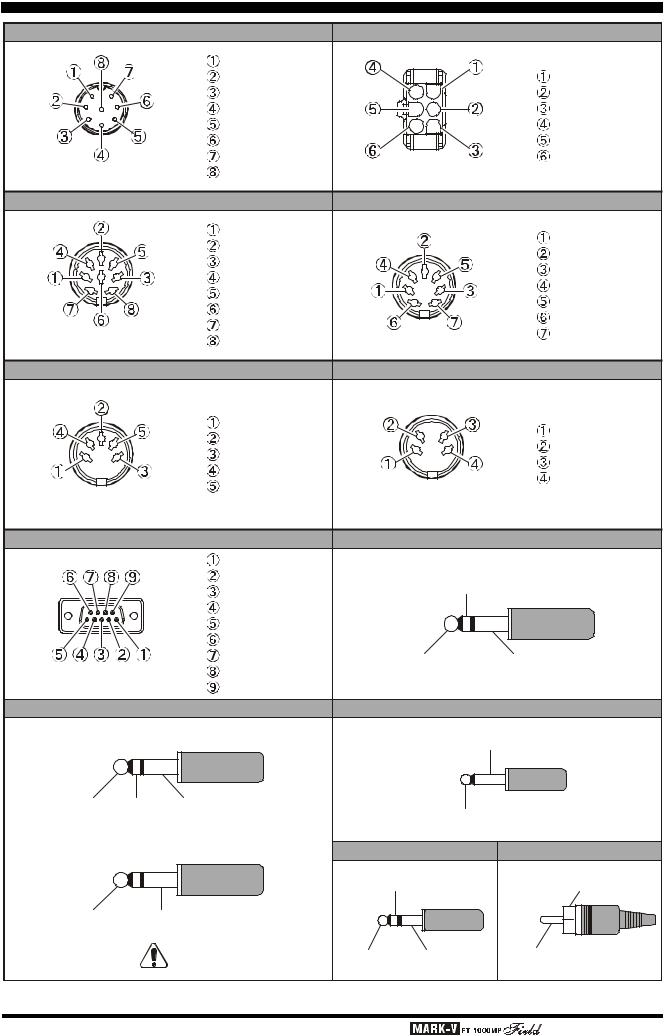
PLUG/CONNECTOR PINOUT DIAGRAMS
MIC |
|
DC IN |
|
|
UP |
|
|
|
+5V |
+13.8 V |
|
|
DOWN |
GND |
|
|
FAST |
N/A |
|
|
GND |
+13.8 V |
|
|
PTT |
GND |
|
|
MIC GND |
N/A |
|
(as viewed from front panel) |
MIC |
(as viewed from rear panel) |
|
|
|||
BAND DATA |
|
DVS-2 |
|
|
+13V |
VOICE IN |
|
|
TX GND |
||
|
VOICE OUT |
||
|
GND |
||
|
PTT |
||
|
BAND DATA A |
||
|
+9V |
||
|
BAND DATA B |
||
|
CNTL 1 |
||
|
BAND DATA C |
||
|
CNTL 2 |
||
|
BAND DATA D |
||
|
GND |
||
|
LINEAR |
||
(as viewed from rear panel) |
(as viewed from rear panel) |
||
|
|||
PACKET |
|
RTTY |
|
Use this jack for AFSK digita-mode connections |
Use this jack for FSK RTTY connections |
||
DATA IN
GND
SHIFT
PTT
RX OUT
DATA OUT
PTT
BUSY
GND
(as viewed from rear panel) (as viewed from rear panel)
CAT |
NC |
|
PHONE |
|
|
|
|
|
SERIAL OUT |
|
SUB |
|
SERIAL IN |
|
|
|
|
|
|
|
N/A |
|
|
|
GND |
|
|
|
N/A |
|
|
|
N/A |
MAIN |
GND |
|
N/A |
||
|
|
|
|
(as viewed from rear panel) |
NC |
|
|
KEY |
|
REMOTE/EXT SPKR |
|
Internal Keyer
GND
DOT |
DASH |
COMMON |
SIGNAL |
|
|
|
|
|
|
Straight Key |
|
AF OUT |
RCA PLUG |
|
|
|
|
SUB |
|
|
|
|
GND or |
|
KEY |
COMMON |
|
|
|
|
|
Do not use |
MAIN GND |
|
|
|
2-conductor type plug |
SIGNAL or |
|
|
|
|
|
|
Page 4 |
OPERATING MANUAL |

ACCESSORIES & OPTIONS |
|
SUPPLIED ACCESSORIES |
|
Hand Microphone MH-31B8 (depending on transceiver version) ......................................................................... |
1 |
AC Power Cord (T9013282 for 100 - 120 V or T9013285 for 200 - 240 V) .......................................................... |
1 |
Spare Fuse (8-A [Q0000104] for 100 - 120 V or 4-A [Q0000103] for 200 - 240 V) ............................................... |
1 |
RCA Plug (P0090544) ....................................................................................................................................... |
1 |
¼-inch 3-contact Plug (P0090008) ..................................................................................................................... |
1 |
3.5 mm 2-contact Plug (P0090034) .................................................................................................................... |
1 |
3.5 mm 3-contact Plug (P0091046) .................................................................................................................... |
1 |
4-pin DIN Plug (P0091004) ................................................................................................................................ |
1 |
5-pin DIN Plug (P0091006) ................................................................................................................................ |
1 |
Operating Manual .............................................................................................................................................. |
1 |
Warranty Card ................................................................................................................................................... |
1 |
AVAILABLE OPTIONS |
|
TCXO-6 HIGH-STABILITYMASTER REFERENCEOSCILLATOR
For special applications and environments where extra frequency stability is essential, such as for longterm HF packet monitoring under wide temperature variations, the TCXO-6 provides ±0.25-ppm stability the master reference oscillator (after 1 min. @ 25 °C).
MD-100A8X DESK-TOP MICROPHONE
Designed especially to match the electrical and cosmetic features of the MARK-V FT-1000MP Field, the MD-100A8X has a 600 Ohm impedance, and includes an up/down scanning ring and a large PTT switch with latch.
MD-200A8X
ULTRA-HIGH-FIDELITY DESK-TOP MICROPHONE
Designed especially to match the electrical and cosmetic features of the MARK-V FT-1000MP Field, the MD-200A8X includes a new-technology “Variable Side Pressure Control” (VSPC), which allows precise adjustment of the microphone’s audio response without resorting to “active” equalization circuits that can introduce distortion and/or degrade signal-to-noise ratio.
VL-1000 LINEAR AMPLIFIER
FTV-1000 50 MHZ TRANSVERTER &
FRB-5 RELAY UNIT
The FTV-1000 is a high-performance, high-power 5054 MHz transverter compatible with the MARK-V FT1000MP Field. Providing excellent receiver performance and up to 200 Watts of power output, the FTV-1000 is specifically designed for the demanding requirements of 50 MHz DX operators. Among the leading-edge features of the FTV-1000 is a Class-A operating bias selection for the transmitter’s power amplifier stage; during Class-A operation, power output is reduced to 50 Watts, and the high bias current leads to an extraordinarily clean SSB wave-form, with 5th-order intermodulation (IMD) typically suppressed by at least 65 dB.
Besides this unit, you must also purchase the FP29 AC Power Supply and FRB-5 Relay Unit, available from your Yaesu dealer.
The FRB-5 Relay Unit allows interconnection and operation of the FTV-1000 with the MARK-V FT-1000MP
Field Transceiver.
SP-8 LOUDSPEAKER WITH AUDIO FILTERS &
LL-7 PHONE PATCH OPTION
The VL-1000 is an all-solid-state linear amplifier operating on the 160 through 6 meter amateur bands (USA version: 160-15 meters) at a power output level of 1000 Watts on CW and SSB (500 Watts on continuous data modes such as RTTY). The VL-1000 includes a built-in antenna tuner with 240 memories for tuning data, and microprocessor control of the tuning circuitry.
The VL-1000 features input jacks for two different exciters, as well as four antenna jacks for connection of antennas for different bands. Extensive self-test, system monitoring, and protection circuits are provided, with status and tuning information being displayed on a huge Liquid Crystal Display panel.
The companion VP-1000 AC Power Supply provides the necessary voltages for the 48-Volt PA section of the VL-1000.
Selectable audio highand low-pass filters together with a large loudspeaker complement the superb audio characteristics of the MARK-V FT-1000MP Field with your choice of 12 different audio filtering combinations. Two input terminals are provided for multiple transceivers, with a front panel switch to select between them. A (monaural) phone jack is provided on the front panel to take advantage of the audio filters with headphones.
With the optional LL-7 Phone Patch Unit installed in the SP-8, the MARK-V FT-1000MPField can be patched to the public telephone network. The LL-7 includes a hybrid transformer circuit to assure proper impedance matches, and front panel gain controls and level meter to set proper audio levels on the telephone line.
OPERATING MANUAL |
Page 5 |

ACCESSORIES & OPTIONS
AVAILABLE OPTIONS
YH-77STA LIGHTWEIGHT STEREO HEADPHONES
Dual samarium-cobalt transducers with sensitivity of 103dB/mW (±2dB, @1 kHz, 35 Ohms) provide the perfect match for the MARK-V FT-1000MP Field. During dual receive with the YH-77STA, one receiver can be monitored in each ear, allowing easy separation of the signals from the two receivers (or the audio can be mixed, if desired).
DVS-2 DIGITAL VOICE RECORDER
Serving as either a continuous receiver recorder for instant pushbutton playback, or microphone audio recorder for multiple on-air playback, the DVS-2 applies the advantages of random-access solid-state digital memory to serious communications. All data is stored electronically, with no moving parts except your finger and the pushbutton. More information is on page 81.
FH-1 REMOTE CONTROL KEYPAD
The FH-1 is a remote-control accessory designed to enhance the operating flexibility of your MARK-V FT-1000MP Field. The FH-1 permits several remote control features, which may be selected via Menu programming. More information is on page 76.
IF Crystal Filter Options
Five optional crystal filters may be installed in the Main Receiver of the MARK-V FT-1000MP Field, and one in the Sub Receiver.
Optional Main Receiver Filters
8.2 MHz (2nd IF)
YF-114SN: 2.0-kHz BW (for all modes except FM) YF-114CN: 250-Hz BW (for all except AM & FM)
455 kHz (3rd IF)
YF-110SN: 2.0-kHz BW (for all modes except FM) YF-115C Collins Mechanical Filter: 500-Hz BW (for CW & RTTY)
YF-110CN: 250-Hz BW (for CW only)
Optional Sub Receiver Filter
455 kHz (2nd IF)
YF-115C: Collins Mechanical Filter 500-Hz BW (for CW
& RTTY)
Availability of accessories may vary: some accessories are supplied as standard per local regulations and requirements, others may be unavailable in some regions. Check with your Yaesu dealer for additions to the above list.
Page 6 |
OPERATING MANUAL |

Before initiating the installation of your MARK-V FT1000MP Field transceiver, please take the time to review the following safety guidelines.
POWER CONNECTIONS
The MARK-V FT-1000MP Field can be operated from either AC or DC power sources.
When making AC connections to your house wiring, be certain that the voltage at the AC wall outlet matches the voltage label on the rear panel of the transceiver.
If you are connecting to a 13.8 Volt DC source, use the optional E-DC-20 DC Power Cable, and be certain to observe the proper polarity when connecting to your DC power supply. Connect the RED power cable lead to the POSITIVE (+) terminal of the DC source, and the BLACK power cable lead to the NEGATIVE (–) terminal.
GROUND CONNECTIONS
The MARK-V FT-1000MP Field HF transceiver, like any other HF communications apparatus, requires an effective ground system for maximum electrical safety and best communications effectiveness. A good ground system can contribute to station efficiency in a number of ways:
rIt can minimize the possibility of electrical shock to the operator.
rIt can minimize RF currents flowing on the shield of the coaxial cable and the chassis of the transceiver; such currents may lead to radiation which can cause interference to home entertainment devices or laboratory test equipment.
rIt can minimize the possibility of erratic transceiver/ accessory operation caused by RF feedback and/ or improper current flow through logic devices.
An effective earth ground system make take several forms; for a more complete discussion, see an appropriate RF engineering text. The information below is intended only as a guideline.
SAFETY PRECAUTIONS
Typically, the ground connection consists of one or more copper-clad steel rods, driven into the ground. If multiple ground rods are used, they should be positioned in a “V” configuration, and bonded together at the apex of the “V” which is nearest the station location. Use a heavy, braided cable (such as the discarded shield from type RG-213 coaxial cable) and strong cable clamps to secure the braided cable(s) to the ground rods. Be sure to weatherproof the connections to ensure many years of reliable service. Use the same type of heavy, braided cable for the connections to the station ground bus (described below).
Inside the station, a common ground bus consisting of a copper pipe of at least 25 mm (1”) diameter should be used. An alternative station ground bus may consist of a wide copper plate (single-sided circuit board material is ideal) secured to the bottom of the operating desk. Grounding connections from individual devices such as transceivers, power supplies, and data communications devices (TNCs, etc.) should be made directly to the ground bus using a heavy, braided cable.
Do not make ground connections from one electrical device to another, and thence to the ground bus. This so-called “Daisy-Chain” grounding technique may nullify any attempt at effective radio frequency grounding. See the drawing below for examples of proper grounding techniques.
Inspect the ground system – inside the station as well as outside – on a regular basis so as to ensure maximum performance and safety.
Besides following the above guidelines carefully, note that household or industrial gas lines must never be used in an attempt to establish an electrical ground. Cold water pipes may, in some instances, help in the grounding effort, but gas lines represent a significant explosion hazard, and must never be used.
Proper Ground Connection
Transceiver |
Linear |
Power |
|||||||
|
Amplifier |
Supply |
|||||||
|
|
|
|
|
|
|
|
|
|
|
|
|
|
|
|
|
|
|
|
|
|
|
|
|
|
|
|
|
|
|
|
|
|
|
|
|
|
|
|
Improper Ground Connection
Transceiver |
Linear |
Power |
|
Amplifier |
Supply |
|
"Daisy Chain" |
|
OPERATING MANUAL |
Page 7 |

SAFETY PRECAUTIONS
ELECTRICAL SHOCK PREVENTION
Be certain that all station wiring is properly insulated so as to prevent short-circuits which could damage this transceiver and/or accessories connected to it. Be sure to protect power cables from damage due to abrasion by ensuring that they cannot be walked upon nor crushed under rolling chairs, etc. Never route power cables near sharp metallic edges which might cut through protective insulation.
Never spill liquids into this transceiver, and do not drop sharp metallic objects into the transceiver enclosure. Electrical shock may result when you attempt to remove the object.
Unsupervised children should be kept away from any electrical apparatus such as the MARK-V FT1000MP Field transceiver and its accessories.
ANTENNA PRECAUTIONS
Always install antennas such that they can never come in contact with outdoor power lines in the event of a catastrophic antenna support or power line support structure failure. An adequate safety margin is usually provided by separating power lines from the antenna and its support structure [1.5 times the height of the support] plus [the length of any antenna or guy wires attached to the support] plus [the height of the power line support pole].
Ground the antenna support structure adequately, so as to dissipate energy absorbed during a lightning strike. Install appropriate lightning arrestors in the antenna lead-in and rotator cable (if used) according to the arrestor’s instructions.
In the event of an approaching electrical storm, disconnect all antenna lead-in, rotator control, and power cables completely from the station, but only if the storm is not immediately in your area. Do not allow disconnected cables to touch the case of your MARK- V FT-1000MP Field transceiver or accessories, as lightning can easily jump from the cable to the circuitry of your transceiver via the case, causing irreparable damage. If a lightning storm is in progress in your immediate area, do not attempt to disconnect the cables, as you could be killed instantly should lightning strike your antenna, tower, or a nearby power line.
If a vertical antenna is used, be certain that humans and/or pets or farm animals are kept away both from the radiating element (to prevent electrical shock and RF exposure danger) and the ground system (in the event of an electrical storm). The buried radials of a ground-mounted vertical antenna can carry lethal voltages outward from the center of the antenna in the event of a direct lightning strike.
RF FIELD EXPOSURE ADVISORY &
ELECTROMAGNETIC COMPATIBILITY
This transceiver is capable of power output in excess of 50 Watts, so customers in the United States may be required to demonstrate compliance with Federal Communications Commission (FCC) regulations concerning maximum permissible exposure to radio frequency energy. Compliance is based on the actual power output used, feedline loss, antenna type and height, and other factors which can only be evaluated as a system. Information regarding these regulations may be available from your Dealer, your local radio club, from the FCC directly (press releases and other information can be found on the FCC’s site on the World Wide Web at <http://www.fcc.gov>), or from the American Radio Relay League, Inc. (225 Main St., Newington CT 06111 or < http://www.arrl.org >).
Remember to re-evaluate your station’s compliance with these regulations during portable operations such as Field Day or special-event stations.
Regarding electromagnetic compatibility: if this transceiver is used with, or in the vicinity of, a computer or computer-driven accessories, you may need to experiment with grounding and/or Radio Frequency Interference (RFI) suppression devices (such as ferrite cores) to minimize interference to your communications caused by energy from the computer. Com- puter-generated RFI is usually a result of inadequate shielding of the computer’s cabinet or I/O and peripheral connections. While computer equipment may “comply” with RF emission standards, this does not ensure that sensitive amateur radio receivers will not experience interference from the device!
Be certain to use only shielded cables for TNC-to- Transceiver connections. You may need to install AC line filters on the power cord(s) of the suspected equipment, and decoupling ferrite toroidal chokes may be required on interconnecting patch/data cables. As a last resort, you can try installing additional shielding within the computer’s case, using appropriate conductive mesh or conductive shielding tape. Especially check “RF holes” where plastic is used for cabinet front panels.
For further information, consult amateur radio reference guides and publications relating to RFI suppression techniques.
Page 8 |
OPERATING MANUAL |

PRELIMINARY INSPECTION
Inspect the transceiver upon opening the packing carton. Check that all controls and switches work freely, and inspect the cabinet for any damage. Ensure the accessory fuses and plugs pictured on page 4 are included. If any damage is found, document it completely, and contact the shipping company (or dealer, if you purchased it over-the-counter) right away. Save the packing materials in case you need to return the set for service. If you have purchased optional internal accessories separately, install them as described on page 112.
POWER CONNECTIONS
Before connecting AC power, check the label on the rear panel which indicates the AC mains voltage for which your transceiver is currently set. If the voltage on this label does not match your AC mains voltage, a switch on the internal power supply in the transceiver must be moved, and the fuse must be changed (U.S.A. users only). See page 116 for more information and details.
After making certain the AC voltage for which the transceiver is set matches your mains voltage, and that the correct fuse is installed in the fuse holder, connect the supplied AC power cord between the 3-pin ~AC IN jack on the rear panel and the AC wall outlet.
The MARK-V FT-1000MP Field can also be operated from 13.8 Volts DC, negative ground, with any well-regulated DC source being capable of providing 22 Amperes of continuous current.
If you are connecting to a DC source, use the optional E-DC-20 DC Power Cable (with 25-A fuse). Connect the RED power cable lead to the POSITIVE (+) terminal of the DC source, and the BLACK power cable lead to the NEGATIVE (–) terminal, then connect the DC plug from the E-DC-20 to the ...– DC IN jack on the rear panel.
Warning: Our warranty does not cover damage caused by improper supply voltage nor use of an improper fuse.
NOTE
If you have both AC and DC power sources connected at the same time, the MARK-V FT-1000MP Field will automatically select the external DC supply as its power source.
GENERAL SETUP
TRANSCEIVER LOCATION
To assure long life of the components, a primary consideration in setting up the MARK-V FT-1000MP Field is providing for adequate ventilation around the cabinet. The cooling system of the MARK-V FT-1000MP Field must be free to draw cool air in at the lower rear of the transceiver, and to expel warm air out of the upper rear panel. Do not place the transceiver on top of another heat-generating device such as a linear amplifier, and do not place equipment, books or papers on top of the transceiver. Also, provide a few centimeters of space on either side of the transceiver, if possible. Avoid heating vents and window locations that could expose the transceiver to excessive direct sunlight, especially in hot climates.
GROUNDING
For protection from electrical shock, and to ensure proper performance, connect the GND terminal on the rear panel to a good earth ground, using a heavy braided cable of the shortest length possible. All other station equipment should be connected to the same grounding cable, as close together as practical. If you use a computer with or near the MARK-V FT-1000MP Field, you may need to experiment with ground wiring to suppress computer noise in the receiver, and ground loops during transmission.
OPERATING MANUAL |
Page 9 |
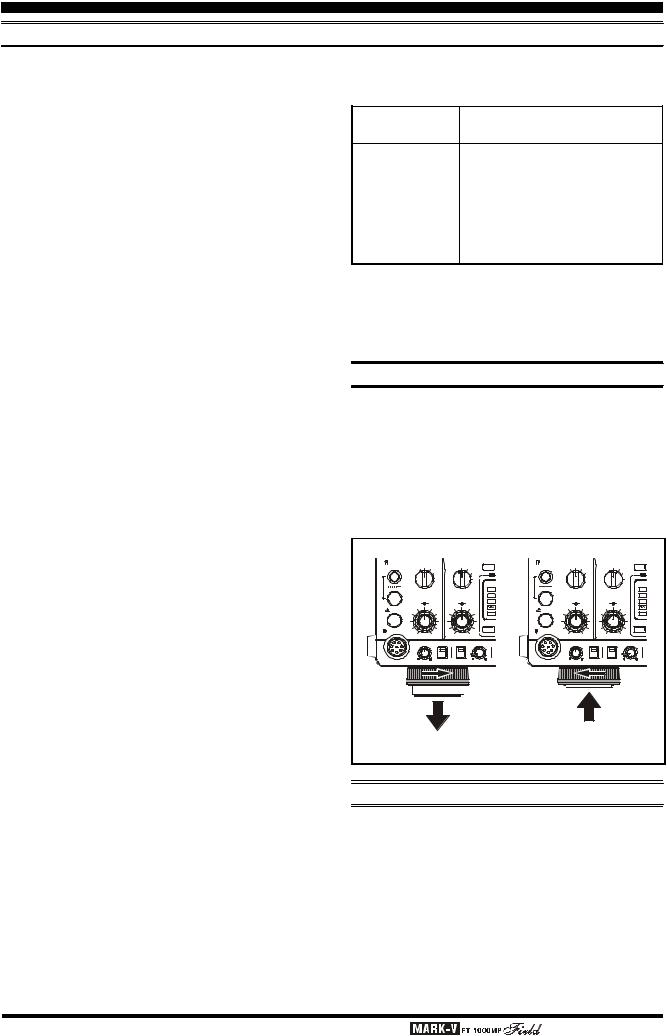
GENERAL SETUP
ANTENNA CONSIDERATIONS
The MARK-V FT-1000MP Field is designed for use with any antenna system providing a 50 W resistive impedance at the desired operating frequency. While minor excursions from the 50 W specification are of no consequence, the transceiver’s Automatic Antenna Tuner may not be able to reduce the impedance mismatch to an acceptable value if the Standing Wave Ratio (SWR) present at the Antenna jack is greater than 3:1. Among the undesirable consequences that high SWR may produce are:
rThe transceiver’s power amplifier protection circuitry will reduce power if the Automatic Antenna Tuner is unsuccessful in reducing the SWR.
rEven if the Automatic Antenna Tuner successfully normalizes the impedance presented to the radio, feedline losses will escalate rapidly with increasing SWR at the higher operating frequencies, especially 28 MHz.
rAlthough high SWR itself does not cause feedline radiation, the sudden onset of high SWR may well indicate a mechanical failure in a matching device, leading to an electrical condition which may cause excessive feedline radiation, which can cause interference to nearby home-entertainment devices.
Every effort should, therefore, be made to ensure that the impedance of the antenna system utilized with the MARK-V FT-1000MP Field be as close as possible to the specified 50 W value.
Loss in dB per 30m (100 feet) for Selected 50 W Coaxial Cables
(Assumes 50 W Input/Output Terminations)
|
Cable Type |
Loss: |
Loss: |
Loss: |
|
|
2 MHz |
15 MHz |
28 MHz |
|
|
|
|
|
|||
|
|
|
|
|
|
|
RG-58A |
0.55 |
1.75 |
2.60 |
|
|
RG-58 Foam |
0.54 |
1.50 |
2.00 |
|
|
RG-8X |
0.39 |
1.07 |
1.85 |
|
|
RG-8A, RG-213 |
0.27 |
0.85 |
1.25 |
|
|
RG-8 Foam |
0.22 |
0.65 |
0.88 |
|
|
Belden® 9913 |
0.18 |
0.50 |
0.69 |
|
|
RG-17A |
0.88 |
0.30 |
0.46 |
|
|
|
|
|
|
|
Loss figures are approximate; consult cable manufacturers’ catalogs for complete specifications.
Loss figures can increase significantly if high SWR is present on the transmission line.
ADJUSTING THE FRONT FEET
The two front feet of the MARK-V FT-1000MP Field can be set in either of two positions. By turning the knurled ring around a (retracted) foot clockwise, the middle of the foot will extend about one centimeter. Turn the ring as far as it will go (about ¼-turn) to lock the extended foot in place. To retract an extended foot, turn the knurled ring counterclockwise ¼-turn while pressing on the center of the foot.
Any antenna to be used with the MARK-V FT1000MP Field must, ultimately, be fed with 50 W coaxial cable. Therefore, when using a “balanced” antenna such as a dipole, remember that a balun or other matching/balancing device must be used so as to ensure proper antenna performance.
PHONES |
|
AGC |
|
ATT |
|
IPO |
A |
|
FAST |
|
0 |
|
|
OFF |
SLOW |
|
6 |
|
||
|
|
|
AUTO |
|
12 |
ED |
|
|
|
|
|
18 |
|
|
|
|
|
|
|
|
|
|
|
|
|
(dB) |
APF |
B |
|
|
|
|
|
240 |
|
|
|
|
|
|
120 |
|
MIC |
PROC |
AF |
RF |
60 |
|
|
GAIN |
GAIN |
|
|||
KEY |
|
|
|
|
|
OFF |
|
|
|
|
|
|
|
|
|
|
|
|
|
APF |
MIC |
|
|
|
|
|
|
|
RF PWR |
PROC |
MONI |
SUB AF |
||
PHONES |
AGC |
|
|
ATT |
I P O |
A |
FAST |
|
|
0 |
|
OFF |
SLOW |
|
6 |
|
|
|
|
AUTO |
|
12 |
ED |
|
|
|
|
18 |
|
|
|
|
|
|
|
|
|
|
|
(dB) |
APF |
B |
|
|
|
|
240 |
|
|
|
|
|
120 |
|
MIC |
PROC |
AF |
RF |
60 |
|
GAIN |
GAIN |
|
||
KEY |
|
|
|
|
OFF |
|
|
|
|
|
|
|
|
|
|
|
APF |
MIC |
|
|
|
|
|
RF PWR PROC MONI SUB AF
The same precautions apply to any additional (re- ceive-only) antennas connected to the RX ANT jack; if your receive-only antennas do not have an impedance near 50 W at the operating frequency, you may need to install an external antenna tuner to obtain optimum performance.
Use high-quality 50 W coaxial cable for the lead-in to your MARK-V FT-1000MP Field transceiver. All efforts at providing an efficient antenna system will be wasted if poor quality, lossy coaxial cable is used. Losses in coaxial lines increase as the frequency increases, so a coaxial line with only 0.5 dB of loss at 7 MHz may have 2 dB of loss at 28 MHz. For reference, the chart in the next column shows approximate loss figures for typically-available coaxial cables frequently used in amateur radio installations.
(To Extend) |
(To Retract) |
MEMORY BACKUP
The memory BACKUP switch on the rear panel is turned on at the factory, allowing VFO and memory data to be retained while power is off. Backup current is miniscule, so it is not necessary to turn the BACKUP switch off unless the transceiver is to be stored for an extended period.
After five or more years of operation the transceiver may fail to retain memories, at which time the lithium battery should be replaced. Contact your dealer for replacement of the battery; for instructions on how to do so yourself, see page 114.
Page 10 |
OPERATING MANUAL |
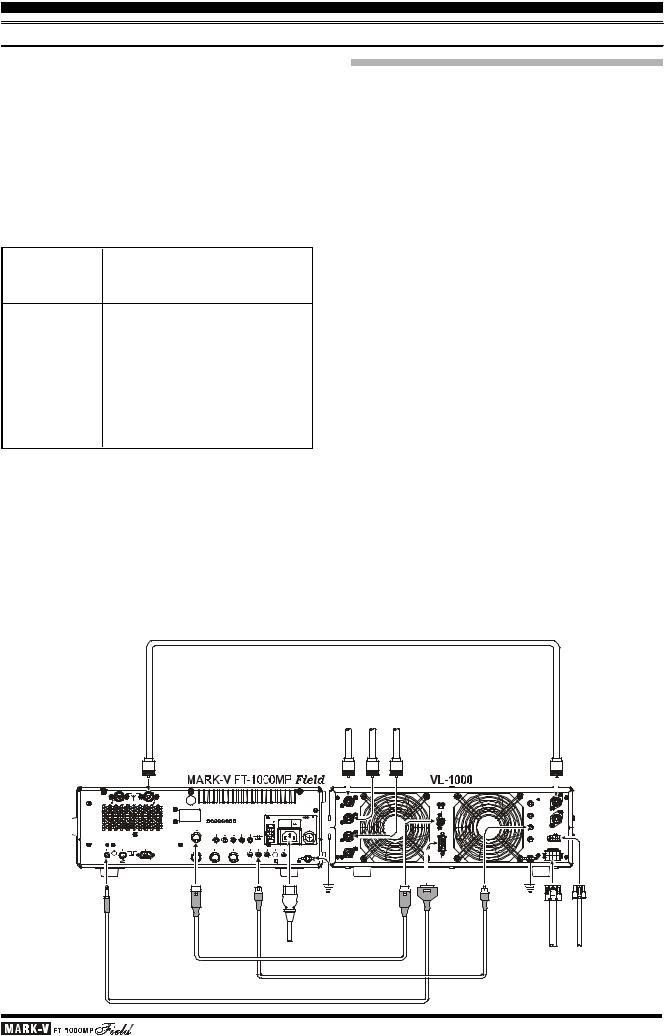
ACCESSORY INSTALLATION
LINEAR AMPLIFIER INTERFACING
The MARK-V FT-1000MP Field can be used with the optional Yaesu FL-7000 or VL-1000 Linear Amplifier, providing automatic band switching via digital band data output from the BANDDATA jack on the rear panel of the transceiver. Most other amplifiers can be adapted to operate with the MARK-V FT-1000MP Field; however, the main points to be concerned with are the switching requirements of the amplifier, and if QSK (full break-in) operation is desired. The linear amplifier Tx/ Rx switching capability of the MARK-V FT-1000MP Field is described in the table below.
|
|
Operation |
|
|
Parameter |
QSK |
Non-QSK |
|
|
Relay Disabled |
Relay Enabled |
|
DC Switching |
< 40VDC |
< 60 VDC |
|
Voltage |
||
|
|
|
|
|
|
|
|
|
DC Swiching |
< 150 mA |
< 200 mA |
|
Current |
||
|
|
|
|
|
AC Switching |
– |
< 100 VAC |
|
Voltage |
||
|
|
|
|
|
|
|
|
|
AC Swiching |
– |
< 500 mA |
|
Current |
||
|
|
|
|
|
|
|
|
OPERATION WITH QSK AMPLIFIERS
Connect the RF output from the transceiver ANT jack (A or B) to the RF input jack of the linear. Connect the ALC output from the linear to the EXT ALC jack on the rear of the transceiver (see the “About ALC” discussion below). After making the RF and Tx/Rx switching connections described below, you may need to adjust the ALC output level of the linear so that it is not overdriven by the MARK-V FT-1000MP Field. Your linear’s manual should describe how to do this.
If using a VL-1000, connect the BAND DATA Cable (supplied with the VL-1000) from the transceiver BAND DATA jack to the amplifier BAND-DATA 1 jack; this will provide automatic band selection for the linear, as well as QSK Tx/Rx switching control. You may also connect a user-constructed control cable (refer to VL-1000 manual for details) from the transceiver REMOTE jack to the amplifier BAND-DATA 2 jack to provide automatic amplifier tune-up for the linear using the MARK- V FT-1000MP Field. Press the VL-1000’s front panel ATT switch to disable the 3 dB input RF power attenuator.
ANTENNA CABLE |
|
|
|
|
VerticalAntenna |
DipoleAntenna |
|
BeamAntenna |
|
HF |
HF |
|
HF |
|
ANT-A |
ANT 1 |
ANT 2 |
ANT 3 |
1 |
INPUT |
||||
|
|
B |
|
ANT |
A |
|
|
|
|
|
|
|
|
|
|
|
|
ANT 1 |
|
|
|
|
|
|
|
|
|
|
|
|
|
|
|
|
|
|
|
|
|
|
|
|
|
|
REMOTE |
|
INPUT 1 |
|
|
|
|
|
|
|
|
|
|
|
|
|
|
|
|
|
|
|
|
|
|
|
PTT 1 |
|
|
|
|
|
|
|
|
|
ACC |
|
|
|
|
|
|
|
|
|
|
|
|
|
ON |
|
|
|
|
|
|
|
|
|
|
|
|
|
|
|
|
|
|
|
|
|
|
|
|
OFF |
|
|
|
|
|
|
|
|
|
|
|
|
|
|
|
|
|
|
|
|
|
|
ANT 2 |
|
BAND DATA 1 |
|
PTT 2 |
|
|
|
|
|
|
|
|
|
|
|
|
|
|
|
|
|
|
|
|
|
|
|
|
INPUT 2 |
|
|
|
|
|
|
|
|
|
|
|
|
|
|
|
|
DC IN |
~ AC IN |
|
|
|
|
|
|
|
||
|
|
|
|
|
|
|
|
|
|
|
|
|
|
I N P U T |
|
|
|
|
|
|
|
|
|
|
|
|
|
|
|
|
|
|
|
|
|
|
|
|
DC13.8V |
|
INPUT |
FUSE |
|
|
|
|
ALC 1 |
|
|
|
|
|
|
|
|
|
|
|
|
|
|
|
|
20 A |
|
AC 100-120V ~ |
T8A |
|
|
|
|
|
|
|
|
|
|
|
|
|
|
|
|
|
|
|
|
|
|
|
50-60Hz 6A |
|
|
|
|
|
|
|
|
|
|
|
|
|
|
BAND DATA |
|
|
|
|
|
|
|
|
|
|
|
ANT 3 |
|
|
|
CONTROL |
|
|
|
|
|
|
|
|
|
+13.8V |
RX ANT |
TRV |
TX GND |
LIN |
|
|
|
|
|
|
|
|
|
|
|
||
|
|
|
|
|
|
|
|
|
|
|
|
|
|
|
|
ALC 2 |
|
|
||||||
|
|
|
|
|
|
|
|
NI |
OUT |
|
OFF |
ON |
|
|
|
|
|
|
|
|
|
|
||
|
|
|
|
|
|
|
DCOUT13.8VP UT |
|
|
|
|
|
|
|
|
|
|
|
|
|
|
|
|
|
|
|
|
|
|
|
|
200 mA |
|
|
|
|
|
|
|
|
|
|
|
|
|
|
|
|
|
REMOTE |
C W |
KEY |
BACKUP |
CAT |
DVS-2 |
PACKET |
|
RTTY |
|
PTT |
EXT |
PATCH |
EXT |
|
|
ANT 4 |
|
|
|
DC48V IN |
|
|
||
|
|
ALC |
|
SPKR AF OUT |
|
|
|
|
|
|
|
|
||||||||||||
|
SIDETONE |
|
OFF |
ON |
|
|
|
|
|
|
|
|
|
|
|
|
|
GND |
|
|
|
GND |
|
|
|
|
|
|
|
|
|
|
|
|
|
|
|
|
|
|
|
|
|
|
|
|
|
||
|
|
|
|
|
|
|
|
|
|
|
|
|
|
|
|
|
|
|
|
BAND DATA 2 |
|
|
|
|
|
REMOTE |
|
|
|
|
|
BANDDATA |
|
|
|
|
|
|
EXTALC |
|
|
~ACIN |
GND |
BAND-DATA1 |
BAND-DATA2 |
ALC1 |
GND |
DC48VIN |
CONTROL |
BAND DATA CABLE (Supplied w/VL-1000)
VP-1000 |
VP-1000 |
ALC CABLE (Supplied w/VL-1000) |
Ü |
Ü |
CONTROL CABLE (See VL-1000 Operating Manual for details)
OPERATING MANUAL |
Page 11 |
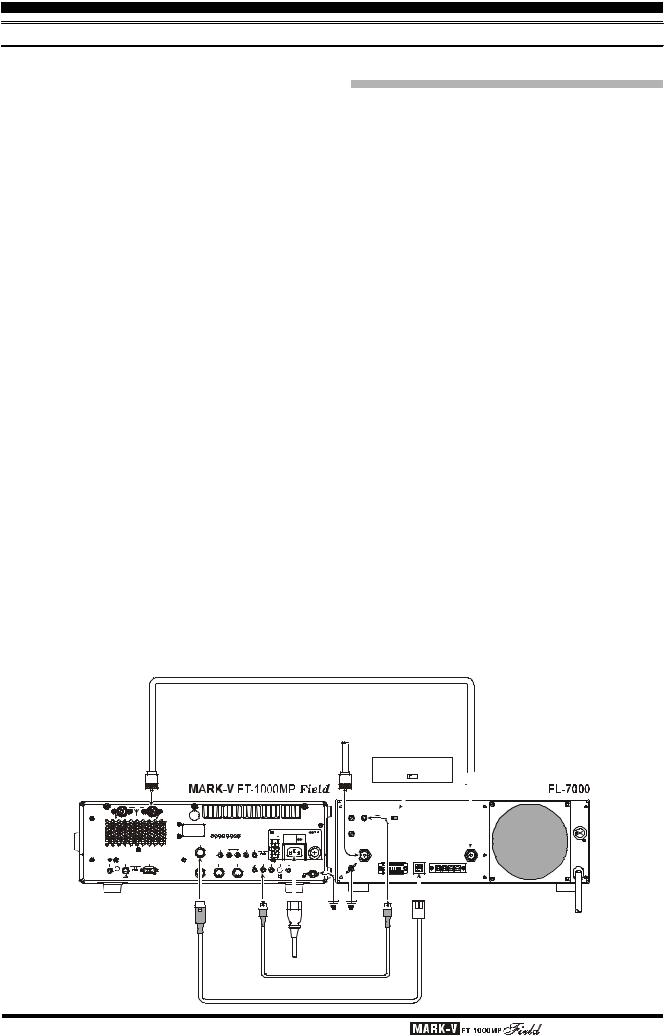
ACCESSORY INSTALLATION
LINEAR AMPLIFIER INTERFACING
If using an FL-7000, connect optional cable E-767 (P/N D4000019) from the transceiver BAND DATA jack to the amplifier ACC-2 jack. This provides automatic band selection for the linear, as well as QSK Tx/Rx switching control. Turn on the FL-7000 rear panel ATT switch to disable the 3 dB input RF power attenuator.
If using another manufacturer’s QSK linear, and if its switching circuitry consumes less than 150 mA of DC voltage below 40 V, you can connect the Tx/Rx switching line for the linear to pin 2 (“TX GND”) of the BAND DATA jack (use pin 3 for ground), and the linear’s exciter-enable output to pin 8 (“TX INHIBIT”) of the BAND DATA jack. This line must be switched to ground to enable transmission once the linear is ready for excitation from the MARK-V FT-1000MP Field. If your QSK linear sinks more than 100 mA or uses more than 15 V for T/R relay switching, you will have to provide a suitable external interface transistor, controlled by pin 2. Be certain to make provision for suitable reduction of the drive power from the MARK-V FT-1000MP Field, so as not to damage your amplifier.
OPERATION WITH NON-QSK AMPLIFIERS (FL-2100 SERIES OR OTHERS)
The TX GND jack on the transceiver rear panel is connected to an internal relay, for non-QSK T/R switching of linear amplifiers that use AC switching voltage, or DC voltage greater than +15 V, negative DC voltage of any kind (such as the Heath® SB-220/SB-221 models), or if they are required to sink more than 100 mA for T/R switching. A schematic diagram of the relay circuit is provided below. If not using your linear amplifier in a full break-in environment, the use of this relay for amplifier switching is highly recommended.
This relay comes disabled (rear-panel LIN set to “OFF”) to avoid the clicking sound when the transceiver is used alone or with a QSK linear. To enable the relay for non-QSK linears that exceed the above T/R switching requirements, you will need to move the LIN switch, located in the hole near the center of the rear panel, to its right position (see the drawing). Use a thin, insulated, sharp object to move the switch. Then connect the center contact of the TX GND jack to the positive relay-control line to your linear, and the outer contact to the “common” line or the linear’s chassis ground. Refer to the diagram at the next page; in this example, a older non-QSK amplifier (FL-2100B) is shown.
With the relay now enabled, the MARK-V FT-1000MP Field can support non-QSK linear T/R switching voltages up to 100 VAC @ 500 mA, or DC voltage up to 60 V @ 200 mA, or closed-circuit current up to 1 A with DC voltage up to 30 V.
ANTENNA CABLE (Supplied w/FL-7000)
|
Antenna |
|
|
HF |
|
A |
1 |
Turn "OFF” the ATT switch |
OFF ATT |
||
ANT- |
ANT |
|
 INPUT
INPUT
|
|
B |
|
A N T |
A |
|
|
|
|
|
|
|
|
|
|
|
|
|
|
|
|
|
|
|
|
|
|
|
|
|
|
|
|
|
|
|
|
|
|
SSB ALC |
ALC |
PTT |
OFF ATT |
|
|
|
|
|
|
|
|
|
|
ACC |
|
|
|
|
|
|
|
|
|
|
|
|
|
|
|
|
|
|
|
|
|
|
|
|
|
|
|
|
|
|
|
|
|
RTTY ALC |
|
|
|
|
|
|
|
|
|
|
|
|
|
|
|
|
|
|
|
|
D C I N |
~ AC IN |
|
|
|
|
|
|
|
||
|
|
|
|
|
|
|
|
|
|
|
|
|
I N P U T |
|
|
|
|
|
|
|
|
|
|
|
|
|
|
|
|
|
|
|
|
|
|
|
D C 1 3 . 8 V |
INPUT |
F U S E |
|
|
|
|
|
|
|
|
|
|
|
|
|
|
|
|
|
|
|
|
|
20 A |
|
AC 100-120V ~ |
T8A |
|
|
|
|
|
|
|
|
|
|
|
|
|
|
|
|
|
|
|
|
|
|
50-60Hz6A |
|
|
|
|
|
|
|
|
|
|
|
|
|
|
BAND DATA |
|
|
|
|
|
|
|
|
|
|
ANT |
|
|
|
|
|
INPUT |
|
|
|
|
|
|
|
+13.8V |
R X A N T |
TRV |
TX GND |
LIN |
|
|
|
|
|
|
|
|
|
|||
|
|
|
|
|
|
|
|
IN |
OUT |
|
OFF |
ON |
|
|
|
|
|
|
|
|
|
|
|
|
|
|
|
|
|
|
|
|
|
|
|
|
|
|
|
|
|
|
|
|
|
||
|
|
|
|
|
|
|
OUTPUT |
|
|
|
|
|
|
|
|
|
|
|
|
|
|
|
|
|
|
|
|
|
|
|
D C2001 3 . 8mAV |
|
|
|
|
|
|
|
|
|
|
|
ACC-1 |
ACC-2 |
REMOTE |
|
|
|
|
|
|
|
|
|
|
|
|
|
|
EXT |
|
|
|
GND |
|
|
|
||||
REMOTE |
C W |
KEY |
BACKUP |
CAT |
DVS-2 |
PACKET |
|
RTTY |
|
PTT |
PATCH |
EXT |
|
|
|
|
|
|
|
|
|||
|
|
ALC |
SPKR AF OUT |
|
|
|
|
|
|
|
|
||||||||||||
|
SIDETONE |
|
OFF |
ON |
|
|
|
|
|
|
|
|
|
|
|
GND |
|
|
|
|
|
|
|
|
|
|
|
|
|
|
|
|
|
|
|
|
|
|
|
|
|
|
|
A |
B |
C |
GND |
BANDDATA |
EXTALC |
~ACIN |
GND |
EXTALC |
ACC-2 |
|
|
ALC CABLE (Supplied w/FL-7000) |
|
|
|
|
E-767 BAND DATA CABLE (Option: P/N D4000019) |
|
|
||
Page 12 |
OPERATING MANUAL |
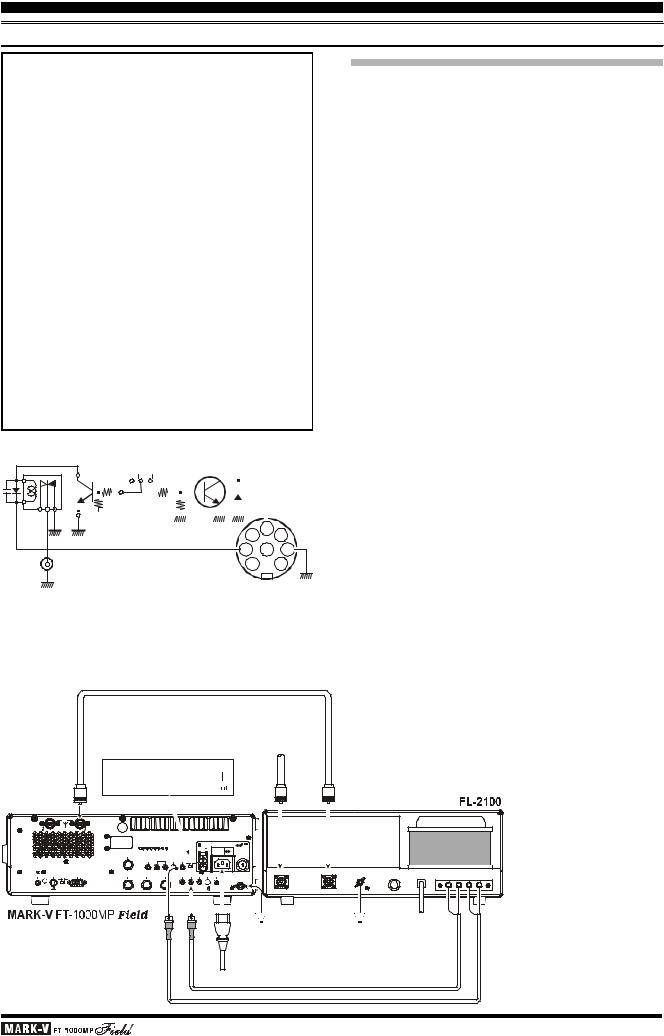
ACCESSORY INSTALLATION
LINEAR AMPLIFIER INTERFACING
Caution - Please Read!!
The MARK-V FT-1000MP Field is designed for use with the FL-7000/VL-1000 when QSK operation with a linear amplifier is desired. If you are using a different amplifier, do not attempt QSK operation with the linear if its switching circuitry requires that the MARK-V FT-1000MP Field’s relay be enabled. Using pins 2 and 8 of the BAND DATA jack for other amplifiers will not work unless the control line signals are carefully matched, and damage may result otherwise.
Your transceiver’s warranty does not cover damage resulting from improper connections to this jack, so if you are not sure of the linear amplifier’s break-in capabilities or switching requirements, the safest approach is to enable the relay, use the TX GND jack (after setting the LIN switch to the “ON” position) and resort to non-QSK operation. This will help prevent possible damage to the amplifier or transceiver.
|
|
|
|
|
|
|
LIN Switch |
|
|
|
Q1008 |
|||||||||||||
|
|
|
|
|
|
|
OFF ON |
40V DC, 150 mA max. |
||||||||||||||||
|
|
|
|
|
|
|
|
|
|
|
|
|
|
|
|
|
|
|
|
|
|
|
|
|
|
|
|
|
|
|
|
|
|
|
|
|
|
|
|
|
|
|
|
|
|
|
|
|
|
|
|
|
|
|
|
|
|
|
|
|
|
|
|
|
|
|
|
|
|
|
|
|
|
|
|
|
|
|
|
|
|
|
|
|
|
|
|
|
|
|
|
|
|
|
|
|
|
|
|
|
|
|
|
|
|
|
|
|
|
|
|
|
|
|
|
|
|
|
|
|
|
|
|
|
|
|
|
|
|
|
|
|
|
|
|
|
|
|
|
|
|
|
|
|
|
|
|
|
|
|
4 |
2 |
5 |
|
1 |
6 |
3 |
TX GND |
7 |
|
8 |
BAND DATA
Jack
HF Antenna
ABOUT ALC
The MARK-V FT-1000MP Field provides an external ALC jack on the rear panel (RCA-type jack) for input of Automatic Level Control voltage from a linear amplifier.
ALC voltage is used to provide dynamic control of the output of the transceiver, so as not to provide more drive than is needed for full amplifier output. The ALC control voltage range is 0 to –4 V DC, with the voltage going more negative as the amplifier’s drive requirements are approaching fulfillment.
The MARK-V FT-1000MP Field’s ALC system is very typical of designs in the amateur radio industry, and consequently is compatible with many manufactured and home-built amplifiers. However, ALC voltage may be generated by an amplifier in a manner incompatible with efficient ALC operation in the MARK- V FT-1000MP Field, and it is important that you recognize the differences in amplifier ALC circuits before proceeding with ALC line connection.
rALC circuits which detect Power Output from the amplifier, and generate negative-going ALC control voltage when maximum output power has been realized, will generally work properly with the MARK- V FT-1000MP Field.
The exact amount of ALC voltage fed to the MARK- V FT-1000MP Field can usually be adjusted via a potentiometer on the rear panel of the amplifier.
rALC circuits which detect Amplifier Tube Grid Current, and generate ALC voltage when excessive grid current is present, may not work well with the MARK-V FT-1000MP Field and other similar transceivers, as the ALC voltage may be generated because of amplifier mis-tuning not related to an ex- cessive-drive condition. With amplifiers deriving their ALC voltage in this manner, we recommend that you not connect the ALC line, and rather let the amplifier’s protection circuitry manage its ALC requirements internally.
|
|
|
|
|
|
|
|
|
|
|
|
|
LIN |
|
|
|
|
|
|
|
When using TX GND jack, |
|
|
OFF ON |
|||||
|
|
|
|
|
|
|
|
|
|
|||||
|
|
|
|
|
A |
move LIN switch to the "ON" position |
|
|
||||||
|
|
|
|
|
ANT- |
|
|
|
|
|
|
|
|
|
|
|
B |
|
ANT |
A |
|
|
|
|
|
|
|
|
|
|
|
|
|
|
|
ACC |
|
|
|
|
|
|
|
|
|
|
|
|
|
|
|
|
|
|
|
|
DC IN |
~ AC IN |
|
|
|
|
|
|
|
|
|
|
|
|
|
INPUT |
|
|
|
|
|
|
|
|
|
|
|
|
|
|
DC 13.8V |
INPUT |
FUSE |
|
|
|
|
|
|
|
|
|
|
|
|
20 A |
AC 100-120V ~ |
T8A |
|
|
|
|
|
|
|
|
|
|
|
|
|
50-60Hz 6A |
|
|
|
|
|
|
|
BAND DATA |
|
|
|
|
|
|
|
|
|
|
|
|
|
|
|
+13.8V |
R X A N T |
TRV TX GND LIN |
|
|
|
||
|
|
|
|
|
|
|
|
IN |
OUT |
|
OFF |
ON |
|
|
|
|
|
|
|
|
|
OUTPUT |
|
|
|
|
|
|
|
|
|
|
|
|
|
|
DC13.8V |
|
|
|
|
|
|
|
|
|
|
|
|
|
|
200 mA |
|
|
|
|
|
|
|
REMOTE |
C W |
KEY |
BACKUP |
CAT |
DVS-2 |
PACKET |
|
RTTY |
PTT |
EXT |
EXT |
AF OUT |
|
|
|
ALC |
PATCH SPKR |
|
|||||||||||
|
SIDETONE |
|
OFF |
ON |
|
|
|
|
|
|
|
|
|
GND |
|
|
|
|
|
|
|
|
|
|
TXGND |
|
EXTALC |
|
~ACIN |
|
1 |
ANT1 |
INPUT |
RF OUT |
RF IN |
GND |
FUSE |
AC |
E |
ALC |
E |
RY |
|
|
|
|
|
|
GND |
|
|
|
GND |
|
|
|
|
|
|
|||
|
|
|
OPERATING MANUAL |
Page 13 |
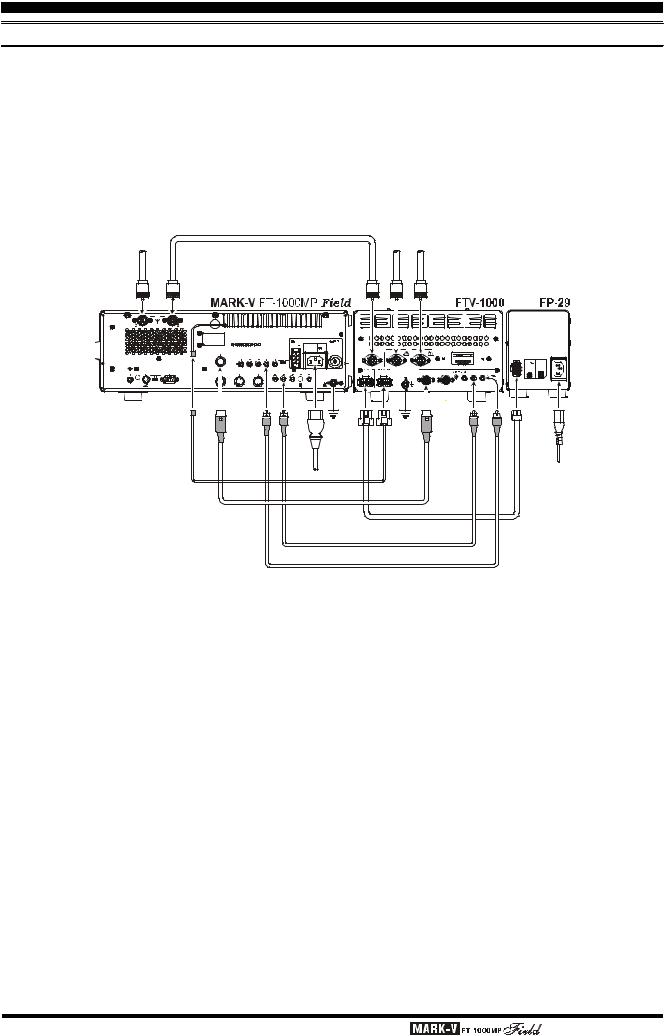
ACCESSORY INSTALLATION
TRANSVERTER OPERATION
The MARK-V FT-1000MP Field can be used with the optional Yaesu FTV-1000 50 MHz Transverter, providing excellent receiver performance and up to 200 Watts of power output.
Besides the FTV-1000, you must purchase the FP29 AC Power Supply and install the FRB-5 Relay Unit into your MARK-V FT-1000MP Field.
A typical FTV-1000 setup is shown below. Installation information for the FRB-5 is provided in the FRB- 5 Installation Manual, while connection and operation instructions for the FTV-1000 may be found in that model’s Operating Manual.
HFAntenna |
|
ANT-B |
ANT-A |
ANTENNA CABLE (Supplied w/FTV-1000)
|
50MHzAntenna |
50MHzAntenna |
TRANSCEIVER |
ANTALT |
ANTNOR |
B A N T A
ACC
|
DC IN |
~ AC IN |
|
|
|
|
|
INPUT |
|
|
|
|
|
|
DC13.8V |
I N P U T |
FUSE |
|
|
|
|
20 A |
AC100-120V~ |
T8A |
|
ANT |
|
|
|
5 0 - 6 0 H z 6 A |
|
|
|
|
BAND DATA |
|
|
TRANSCEIVER |
ALT |
NOR |
FTV-1000 |
+13.8V R X A N T |
TRV TX GND LIN |
|
|
|
|
|
|
|
|
|
IN |
OUT |
|
OFF |
ON |
|
|
|
|
|
|
|
|
|
|
|
|
|
|
|
|
OUTPUT |
|
|
|
|
|
|
|
|
|
|
|
|
|
|
|
|
|
|
|
|
D C2001 3 . 8mAV |
|
|
|
|
|
|
|
|
|
|
|
|
|
|
|
|
|
C W |
|
|
|
|
|
EXT |
|
EXT |
|
|
|
|
|
|
|
|
|
|
|
REMOTE |
KEY BACKUP CAT |
DVS-2 |
PACKET |
RTTY |
PTT |
ALC |
PATCH SPKR |
AF OUT |
|
FROM FP-29 |
TO MARK-V FT-1000MP |
|
BAND DATA LIN BAND DATA |
ALC |
TX IN |
ATT |
|
|
||
|
SIDETONE |
OFF ON |
|
|
|
|
|
|
|
GND |
|
|
|
GND |
|
|
|
OFF ON |
|
|
|
|
|
|
|
|
|
|
|
|
|
|
|
|
|
|
|
|
|
|
|
|
|
ACC |
|
BANDDATA |
(BLACK) TRV |
|
|
(GRAY) EXTALC |
~ACIN |
GND |
DCPOWERIN |
|
DCPOWEROUT |
GND |
BANDDATA |
|
(GRAY) ALC |
(BLACK) TXIN |
OUTPUT |
INPUT |
|
CONNECTION CABLE B |
|
|
|
|
|
|
|
|
|
|
|
|
|
|
|
|
|
|
|
|
(Supplied w/FRB-5A) |
|
|
|
|
|
|
|
|
|
|
|
|
|
|
|
|
|
|
|
BAND DATA CABLE (Supplied w/FTV-1000)
DC POWER CABLE (Supplied w/FP-29)
ALC CABLE (Supplied w/FTV-1000)
TRV CABLE (Supplied w/FTV-1000)
Page 14 |
OPERATING MANUAL |
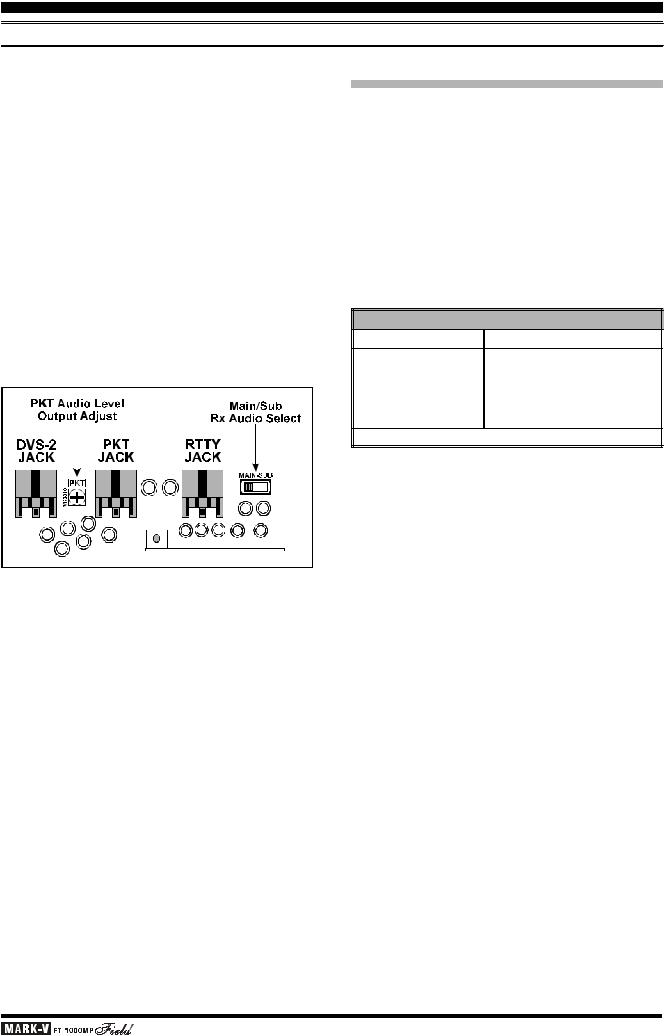
ACCESSORY INSTALLATION
DIGITAL MODEM (TNC, WEATHERFAX, ETC.) INTERFACING
The MARK-V FT-1000MP Field offers special features for digital modes, such as a built-in digitally-syn- thesized AFSK generator for RTTY and AMTOR terminal units, IF bandwidth optimization and automatic display offsets, and an 18-ms transmit-to-receive turnaround time.
Low-level Main Receiver audio output is provided from the rear-panel RTTY and PKT jacks, and is unaffected by front panel volume control settings. If you prefer to use Sub Receiver audio for TNC input, switch S3001 (located on the AF UNIT circuit board, inside the transceiver, between the DVS-2 and PKT connectors) can be moved from the MAIN to the SUB position.
Audio level is 100 mV from both jacks. The RTTY level is fixed; however, PKT audio level can be adjusted by potentiometer VR3010. In many cases, it is easier to perform level adjustments at the TNC.
DIGITAL MODES WITH A TNC
OR COMPUTER SOUND CARD (PSK-31)
The explosion of new digital modes of amateur communication means that you will want to make connections to your TNC and/or computer as “standardized” as possible. Generally, this will mean that you will want to connect your transceiver in an “AFSK” environment. On the MARK-V FT-1000MP Field, the PACKET jack is the “AFSK” connection port, while the RTTY jack is an “FSK” connection port. In the AFSK mode, the TNC or computer generates the data signal as a set of audio tones, while the FSK mode uses a closure to ground (in the TNC or terminal unit) to cause the transceiver to generate the “mark” and “space” tones.
PACKET TONE INFORMATION
TNC Tone Pair |
Tone Center Frequency |
1070/1270 Hz |
1170 Hz |
|
|
1600/1800 Hz |
1700 Hz |
|
|
2025/2225 Hzø |
2125 Hzø |
2110/2310 Hz |
2210 Hz |
ø indicates default setting (used by normal convention)
OPERATING MANUAL |
Page 15 |
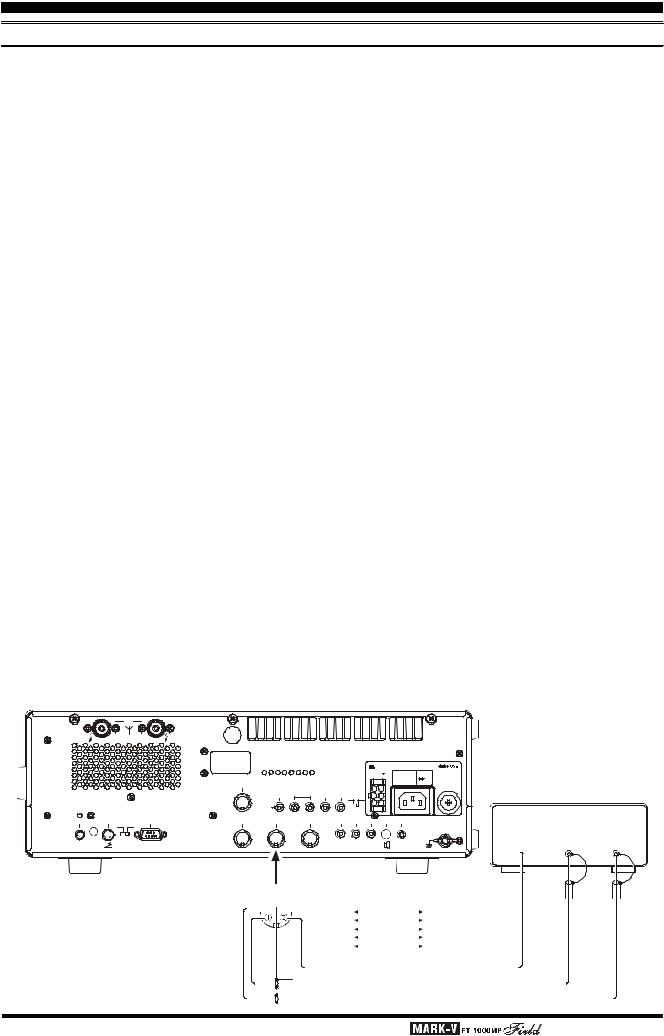
ACCESSORY INSTALLATION
DIGITAL MODEM (TNC, WEATHERFAX, ETC.) INTERFACING
Construct a patch cable or cables to make the necessary connections between your TNC and the appropriate rear panel jack(s) (RTTY for FSK, PACKET for AFSK). Refer to the pin-out diagram below, and the wiring instructions included with your TNC. A description of the PACKET jack’s individual pins follows:
Pin 1 (DATA IN) - Connect this pin to your TNC’s “AFSK Out” or “Mic Audio” output line. The optimum input level is 30 mV rms, and the input impedance is 3 kW. Your TNC’s audio output level potentiometer will allow you to set the level to the optimum value. This pin may be used either for 300 baud SSB-mode digital operation or for 1200-baud FM packet. The bandwidth and frequency response are not, however, suitable for 9600 baud operation.
Pin 2 (Ground) - Connect this to the shield(s) of the cable(s) used for connections between the TNC and the MARK-V FT-1000MP Field.
Pin 3 (PTT) - Connect this pin to the PTT line from the TNC. This pin, when grounded by the TNC, places the MARK-V FT-1000MP Field into the Transmit condition.
Pin 4 (DATA Out) - Connect this pin to your TNC’s “RX Audio” input line. This is a constant-level (100 mV rms @ 600 W) audio output line which is not affected by theposition ofthe front-panelAF GAIN control.
Pin 5 (BUSY) - This is a “Squelch Status” pin not generally required for digital mode operation. This pin is held at +5V when the squelch is open, and is grounded when the receiver is muted by the squelch (“no-signal” condition).
For FSK operation using the RTTY jack, the following are the pin connections required:
Pin 1 (SHIFT) - Connect this pin to your TNC or terminal unit’s “FSK Key” port. Closing and opening of this line to ground causes mark/space keying.
Pin 2 (RX AF OUT) - Same as “DATA OUT” on
PACKET jack.
Pin 3 (PTT) - Same as “PTT” on PACKET jack.
Pin 4 (GND) - Same as “GND” on PACKET jack.
For operation on PSK31, connect your computer's sound card to the PACKET jack (for “PKT” mode operation) or the MIC and EXT SP jacks (for “SSB” mode operation). Also, use menu selection 8-6 to configure the “User” mode (see page 110) for PSK31 operation.
For most operation, you will want to use the PS31- U (for PKT mode) or PS31-SU (for USB mode) options under “East Set;” while BPSK operation is not sideband-sensitive, QPSK operation, by convention, utilizes USB-side injection.
The “User” mode is accessed, during operation, by pressing and holding in for ½ second the [PKT] mode switch.
MARK-V FT-1000MP Field
B ANT A
ACC
DC IN |
~ AC IN |
|
|
|
|
|
|
|
|
|
|
|
|
|
INPUT |
|
|
|
|
|
|
|
|
|
|
|
|
|
|
|
DC 13.8V |
INPUT |
FUSE |
|
|
|
|
|
|
|
|
|
|
|
|
|
20 A |
AC 100-120V ~ |
T8A |
|
|
|
|
|
|
|
|
|
|
|
|
|
|
50-60Hz 6A |
|
|
|
|
|
|
|
BAND DATA |
|
|
|
|
|
|
|
|
|
|
|
|
|
|
|
|
+13.8V |
RX ANT |
TRV TX GND |
LIN |
|
|
|
|
|
|
|
|
|
|
|
|
|
IN |
OUT |
|
OFF |
ON |
|
|
|
|
|
|
|
|
|
|
|
|
|
|
|
|
|
||
|
|
|
|
|
|
|
OUTPUT |
|
|
|
|
|
|
|
|
|
|
|
|
|
|
|
DC 13.8V |
|
|
|
|
|
|
|
|
|
|
|
|
|
|
|
200 mA |
|
|
|
|
|
|
|
|
REMOTE |
|
KEY |
BACKUP |
CAT |
DVS-2 |
PACKET |
|
RTTY |
PTT |
EXT |
EXT |
AF OUT |
|
||
C W |
|
ALC |
PATCH SPKR |
|
|||||||||||
|
SIDETONE |
|
OFF |
ON |
|
|
|
|
|
|
|
|
|
|
GND |
|
|
|
|
|
|
|
|
|
|
|
|
|
|
|
|
TNC
DATA DATA PTT OUT IN
PACKET 

PACKET JACK |
TNC |
|
Pin 1 |
|
DATA OUT |
|
||
Pin 2 |
|
GND |
|
||
Pin 3 |
|
PTT |
|
||
Pin 4 |
|
DATA IN |
|
||
Pin 5 |
|
(SQL Control) |
|
||
|
|
|
|
|
|
|
|
|
|
|
|
|
|
|
|
|
|
|
Page 16 |
|
|
OPERATING MANUAL |
||||
|
|
||||||
|
|
||||||
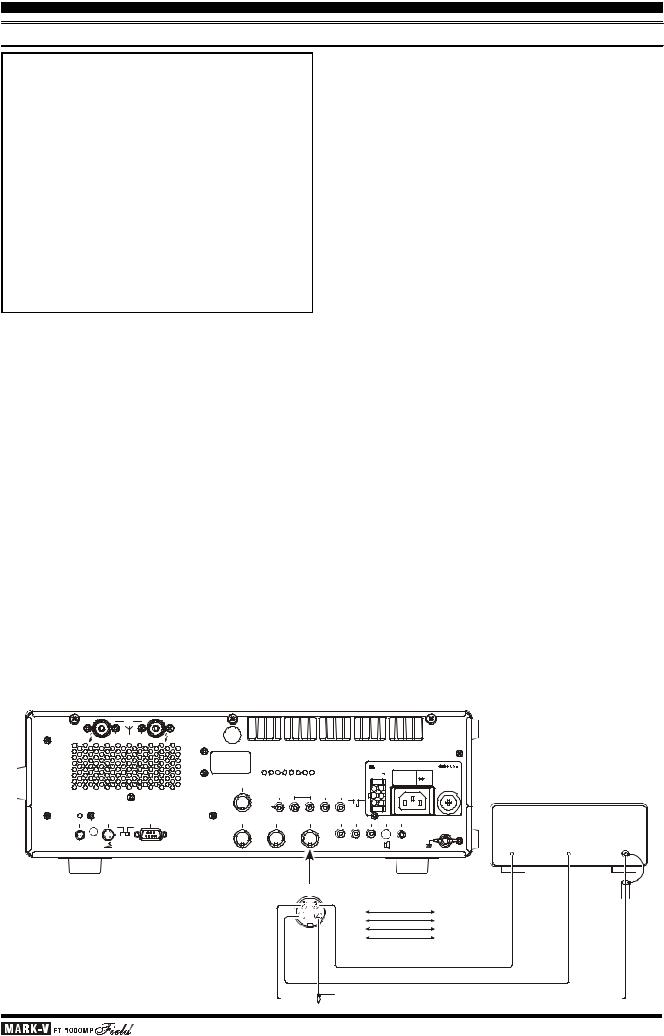
ACCESSORY INSTALLATION
DIGITAL MODEM (TNC, WEATHERFAX, ETC.) INTERFACING
CAUTION!!
The MARK-V FT-1000MP Field cooling system is designed to handle continuous duty transmission at 100 watts output. However, for continuous-duty digital modes like RTTY, we recommend limiting your transmissions to 3 minutes or less, with at least 3 minutes receive in between transmissions. Place your hand on the transceiver occasionally to ensure that it’s not getting too hot, and try to keep power output at 50 watts or less.
You can limit the maximum RF power output to 25 watts via programming, by recalling menu selection 4-0 and choosing reduced power output.
MARK-V FT-1000MP Field
B ANT A
ACC
|
|
|
|
|
|
|
|
|
|
|
|
|
DC IN |
~ AC IN |
|
|
|
|
|
|
|
|
|
|
|
|
|
|
INPUT |
|
|
|
|
|
|
|
|
|
|
|
|
|
|
|
DC 13.8V |
INPUT |
FUSE |
|
|
|
|
|
|
|
|
|
|
|
|
|
20 A |
AC 100-120V ~ |
T8A |
|
|
|
|
|
|
|
|
|
|
|
|
|
|
50-60Hz 6A |
|
|
|
|
|
|
|
BAND DATA |
|
|
|
|
|
|
|
|
TNC |
|
|
|
|
|
|
|
+13.8V |
IN |
OUT |
TRV TX GND |
LIN |
|
|
|
|
|
|
|
|
|
|
|
RX ANT |
|
|
|
|
||||
|
|
|
|
|
|
|
|
|
|
|
OFF |
ON |
|
|
|
|
|
|
|
|
|
|
OUTPUT |
|
|
|
|
|
|
|
|
|
|
|
|
|
|
|
DC 13.8V |
|
|
|
|
|
|
|
|
|
|
|
|
|
|
|
200 mA |
|
|
|
|
|
|
|
|
REMOTE |
|
KEY |
BACKUP |
CAT |
DVS-2 |
PACKET |
|
RTTY |
PTT |
EXT |
EXT |
AF OUT |
|
||
C W |
|
ALC |
PATCH SPKR |
|
|||||||||||
|
SIDETONE |
|
OFF |
ON |
|
|
|
|
|
|
|
|
|
|
GND |
|
|
|
|
|
|
|
|
|
|
|
|
|
|
|
|
PTT FSK OUT AF IN
RTTY |
RTTY JACK |
RTTY Machine |
|
Pin 1 |
FSK OUT |
|
Pin 2 |
AF IN |
|
Pin 3 |
PTT |
|
Pin 4 |
GND |
|
|
|
|
|
|
|
OPERATING MANUAL |
|
|
|
|
Page 17 |
|
|
|
|
||||

ACCESSORY INSTALLATION
DIGITAL MODEM (TNC, WEATHERFAX, ETC.) INTERFACING
NOTE: COMPUTER-GENERATED RFI
When using a TNC connected to your transceiver, or even having a PC located in the shack, the possibility exists that you may experience computer-generated RFI (Radio Frequency Interference).
The CPU in a personal computer operates with a crystal-controlled oscillator (clock), which may generate harmonics or other spurious signals. In addition, high-speed digital data switching uses square waves, which produce odd-order harmonic frequencies.
Computer-generated RFI may appear at seemingly random frequencies (usually right where a rare DX station is calling CQ!) throughout the range of your transceiver, and may sound like constant ticking or buzzing that may change as you type or work within a program. Severe RFI may have S-meter indications as much greater than S-9, making copy of voice signals difficult and data signals virtually impossible.
Computer-generated RFI is usually a result of inadequate shielding of the PC’s cabinet or I/O and peripheral connections. While computer equipment may comply with RF emission approval standards, this does not ensure that sensitive amateur radio receivers will not experience RFI from the device.
There are a few steps you can take to reduce or eliminate computer-generated RFI. The first step is to ensure that only shielded cables are used for TNC-to- transceiver connections, carefully check RF ground connections and re-orient your station equipment in relation to the computer. Try moving your PC and peripherals slightly and see if it has any affect on the RFI, in some cases, this alone may be enough to correct the problem.
If not, several additional steps to try include installing AC line filters on the power cord(s) of the suspected equipment and inserting decoupling ferrite toroidal chokes on interconnecting patch/data cables and smaller ferrite beads on single wires.
As a last resort, you can try installing additional shielding within the PC case, using appropriate conductive mesh/screening or conductive tape. Especially check RF “holes” where plastic is used for cabinet front panels. For further information, consult amateur radio reference guides and publications relating to RFI suppression techniques.
Page 18 |
OPERATING MANUAL |
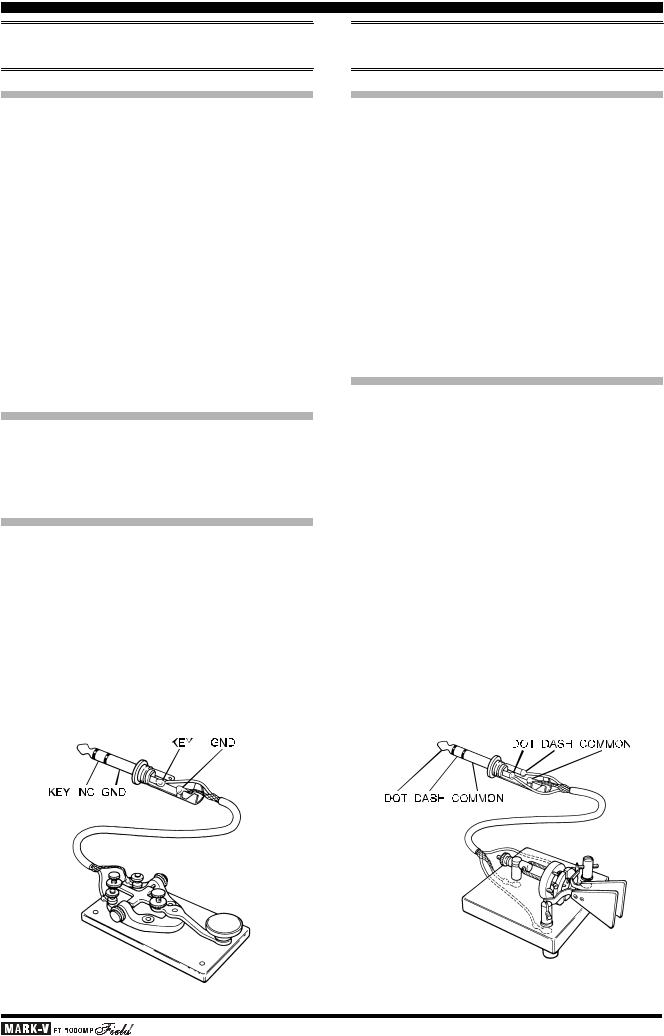
OTHER DIGITAL/RECORDING DEVICE
INTERFACING
AF OUT JACK
This is a 3.5 mm miniature stereo phone jack which provides constant-level (100 mV @ 600 W) for connection to a WeatherFax decoder, tape recorder, or other accessory. The audio output level is not affected by the setting of the front panel AF GAIN & SUB AF controls, so you can turn the volume down, if you like, without affecting the audio level being presented to your decoding device. The tip connection of this jack is Main receiver audio, while the ring connection is Sub receiver audio.
The connections to the AF OUT jack are at the same level as the connection to Pin 4 of the PACKET jack. However, the two output ports use independent output buffer amplifiers, so you can freely connect and disconnect devices to/from these ports without concern over the impedances and levels.
PTT (PUSH TO TALK) JACK
This RCA jack is wired in parallel with the front panel’s MIC jack, providing a handy connection point for a footswitch for voice operation, allowing handsfree PTT operation.
PATCH JACK
For transmit audio input for SSTV (Slow-Scan Television) operation, you may connect the SSTV terminal’s TX AUDIO line to the PATCH jack. You will need to disconnect the microphone, however, during transmission, as the PATCH jack is connected in a “Y” configuration along with the microphone input (from pin 8 of the MIC jack).
ACCESSORY INSTALLATION
CW KEY/PADDLE AND COMPUTER
KEYING INTERFACE SUGGESTIONS
FEATURES
The MARK-V FT-1000MP Field includes a host of features for the CW operator, the functions of which will be detailed in the “Operation” section later. Besides the built-in Electronic Keyer, two key jacks are provided, one each on the front and rear panels, for convenient connection to keying devices.
Both KEY jacks on the MARK-V FT-1000MP Field utilize “positive” keying voltage. Key-up voltage is approximately +5V DC, and key-down current is approximately 0.5 mA. When connecting a key or other device to the KEY jacks, use only a 3-pin (“stereo”) ¼” phone plug; a 2-pin plug will place a short between the ring and (grounded) shaft of the plug, resulting in a constant “key-down” condition in some circumstances.
CONFIGURATION SUGGESTIONS
1.For everyday operation using the internal electronic memory keyer, connect your paddle to the front panel KEY jack, and activate the front panel [KEY] switch. If you wish to keep the keyer paddle’s cable out of the way, connect the plug, instead, to the rear panel KEY jack.
2.If two operators are using the MARK-V FT-1000MP Field simultaneously (for a contest, Field Day, etc.), a second keyer paddle may be connected to the rear panel KEY jack. With the front panel [KEYER] switch pressed in, both operators’ paddles will have access to the internal keyer.
3.If two operators are using the MARK-V FT-1000MP Field simultaneously, but both wish to use a straight key, outboard electronic keyer, or computer-driven keying cables, the key plugs may be inserted into the front and rear panel KEY jacks; now turn the front panel’s [KEYER] switch off.
OPERATING MANUAL |
Page 19 |
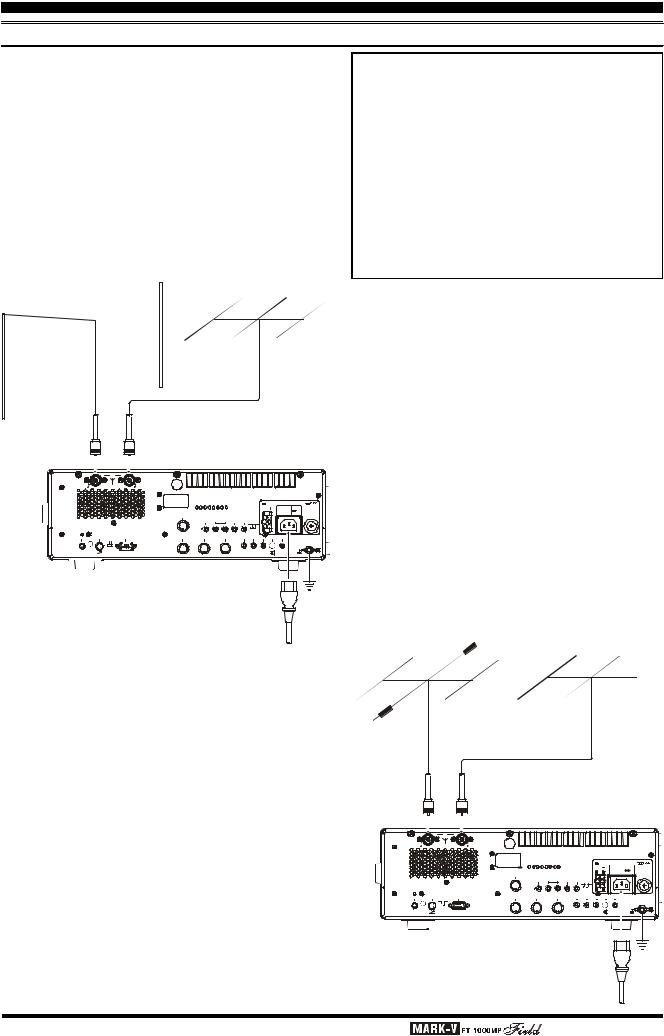
ACCESSORY INSTALLATION
ANTENNA CONNECTIONS
The MARK-V FT-1000MP Field’s three antenna connectors, plus innovative microprocessor-based memory and switching circuits, provide excellent flexibility in setting up your antenna connections.
Typical antenna configurations are shown below. Remember that Antenna A and Antenna B (which are “SO-239” or “M” connectors) may be used for transmission and reception, while the RX Antenna port (which is an “RCA” type connector) may only be used for reception.
NOTE REGARDING
LARGE RECEIVE ANTENNAS
Although surge suppression is provided on all antenna ports, you may wish to consider building a simple external circuit which will disconnect, on TX, any antenna connected to the RX ANT IN jack, particularly if you are using a very long wire antenna such as a Beverage. Very long antennas can build up very high RF and static voltages on them, and the circuit below may provide better protection for your receiver’s input circuitry.
7MHz Dipole
14/21/28 MHz Tribander
ANTENNA"B" |
|
ANTENNA"A" |
B |
A N T |
A |
REMOTE |
CW |
KEY BACKUP |
CAT |
||||||||
|
|
SIDETONE |
|
|
OFF |
|
ON |
|
|
|
|
|
|
|
|
|
|
|
|
|
|
|
|
|
|
|
|
|
|
|
|
|
|
|
|
|
|
|
|
|
|
|
|
|
|
|
|
|
|
|
|
|
|
|
|
|
|
|
|
MARK-V FT-1000MP Field
ACC |
|
|
|
|
|
|
|
|
|
|
|
|
|
|
|
|
|
|
|
DC IN |
~ AC IN |
||
|
|
|
|
|
|
|
|
INPUT |
|
|
|
|
|
|
|
|
|
|
|
DC 13.8V |
|
INPUT |
FUSE |
|
|
|
|
|
|
|
|
20 A |
|
AC 100-120V ~ |
T8A |
|
|
|
|
|
|
|
|
|
|
50-60Hz 6A |
|
BAND DATA |
|
|
|
|
|
|
|
|
|
|
|
|
+13.8V |
RX ANT |
TRV |
TX GND |
LIN |
|
|
|
|
|
|
|
|
IN |
OUT |
|
OFF |
O N |
|
|
|
|
|
|
OUTPUT |
|
|
|
|
|
|
|
|
|
|
|
DC 13.8V |
|
|
|
|
|
|
|
|
|
|
|
200 mA |
|
|
|
|
|
|
|
|
|
|
|
|
|
|
|
|
EXT |
|
|
EXT |
|
|
DVS-2 |
PACKET |
|
RTTY |
|
PTT |
ALC |
PATCH |
SPKR AF OUT |
|
||
|
|
|
|
|
|
|
|
|
|
|
GND |
~ACIN |
GND |
7/14/21 MHz Tribander
28 MHz 5el Yagi
ANTENNA"B" |
ANTENNA"A" |
MARK-V FT-1000MP Field
B ANT A
A C C
DC IN |
~ AC IN |
||
INPUT |
|
|
|
DC13.8V |
INPUT |
FUSE |
|
20 A |
AC 100-120V ~ |
T8A |
|
|
|
50-60Hz 6A |
|
|
|
|
|
BAND DATA
|
|
|
|
|
|
|
+13.8V |
RX ANT |
TRV |
TX GND |
LIN |
|
|
|
|
|
|
|
|
|
|
|
|
|
NI |
OUT |
|
OFF |
O N |
|
|
|
|
|
|
|
|
|
|
|
|
|
|
|
|
|
|
|
||
|
|
|
|
|
|
|
OUTPUT |
|
|
|
|
|
|
|
|
|
|
|
|
|
|
|
|
DC 13.8V |
|
|
|
|
|
|
|
|
|
|
|
|
|
|
|
|
200 mA |
|
|
|
|
|
|
|
|
|
REMOTE |
|
KEY |
BACKUP |
CAT |
DVS-2 |
PACKET |
|
RTTY |
|
PTT |
EXT |
PATCH |
E X T |
|
||
CW |
|
|
ALC |
SPKR AF OUT |
|
|||||||||||
|
SIDETONE |
|
OFF |
O N |
|
|
|
|
|
|
|
|
|
|
|
GND |
|
|
|
|
|
|
|
|
|
|
|
|
|
|
|
|
|
|
|
|
|
|
|
|
|
|
|
|
|
|
|
|
~ACIN |
GND |
Page 20 |
OPERATING MANUAL |
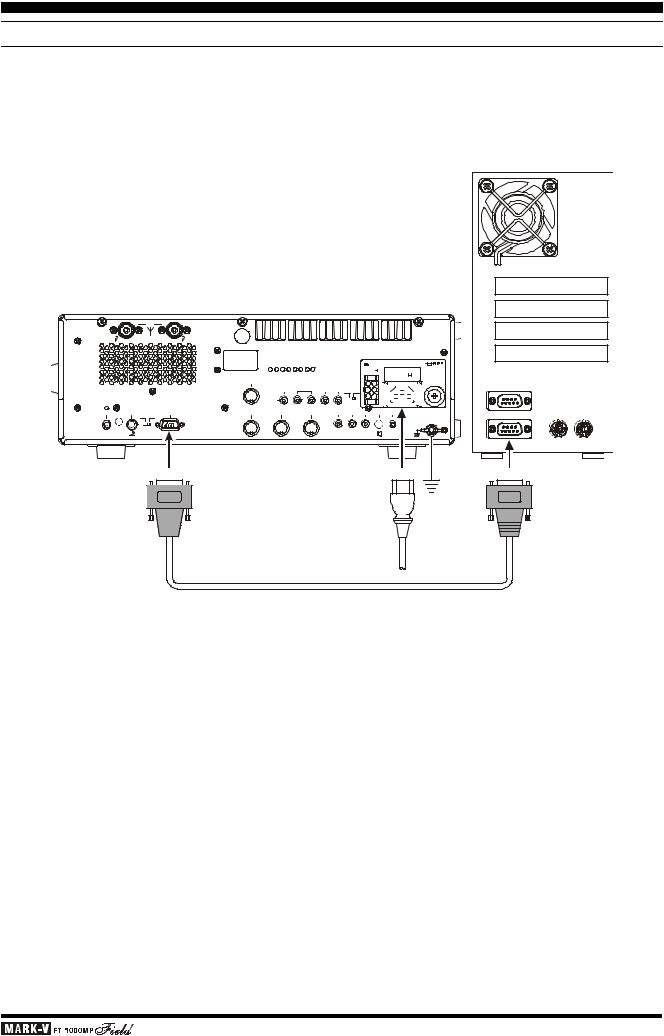
|
ACCESSORY INSTALLATION |
|
|
PERSONAL COMPUTER INTERFACING FOR CONTEST SOFTWARE, ETC. |
|
The MARK-V FT-1000MP Field features a built-in |
Details regarding the programming protocols for the |
level converter, allowing direct connection from the rear- |
CAT system may be found beginning on page 86. |
panel CAT jack to the serial port of your computer, |
|
without the need for any external converter box. |
|
When your software requests serial port configuration information, set it for “4800,N,8,2” (4800 baud, No Parity, 8 Data Bits, and 2 Stop Bits). Be certain to configure and activate any required “TSR” (Terminate-and- Stay-Resident) utilities before beginning computer-con- trolled transceiver operation (your software’s instruction manual will describe any such requirement).
B |
ANT |
A |
|
|
A C C |
DC IN |
~ AC IN |
|
|
|
|
|
INPUT |
|
|
|
|
|
DC 13.8V |
|
|
|
|
|
20 A |
BAND DATA |
|
|
|
|
|
+13.8V |
RX ANT |
TRV |
TX GND LIN |
|
|
|
IN |
OUT |
|
OFF |
ON |
|
|
|
|
||
OUTPUT |
|
|
|
|
|
DC 13.8V |
|
|
|
|
|
200 mA |
|
|
|
|
|
|
INPUT |
FUSE |
|
||||||||
|
AC 100-120V ~ |
T8A |
|
||||||||
|
50-60Hz 6A |
|
|
|
|
||||||
|
|
|
|
|
|
|
|
|
|
|
|
|
|
|
|
|
|
|
|
|
|
EXT |
|
EXT |
|
|
REMOTE |
CW |
KEY |
BACKUP |
CAT |
DVS-2 |
PACKET |
RTTY |
PTT |
ALC |
PATCH |
SPKR AF OUT |
|
|
|
|
SIDETONE |
|
OFF |
ON |
|
|
|
|
|
|
|
|
GND |
|
|
|
|
|
|
|
|
|
|
|
|
|
|
|
|
|
|
|
|
|
|
CAT |
|
|
|
|
|
~ACIN |
GND |
COM2 |
RS-232C Cable
OPERATING MANUAL |
Page 21 |
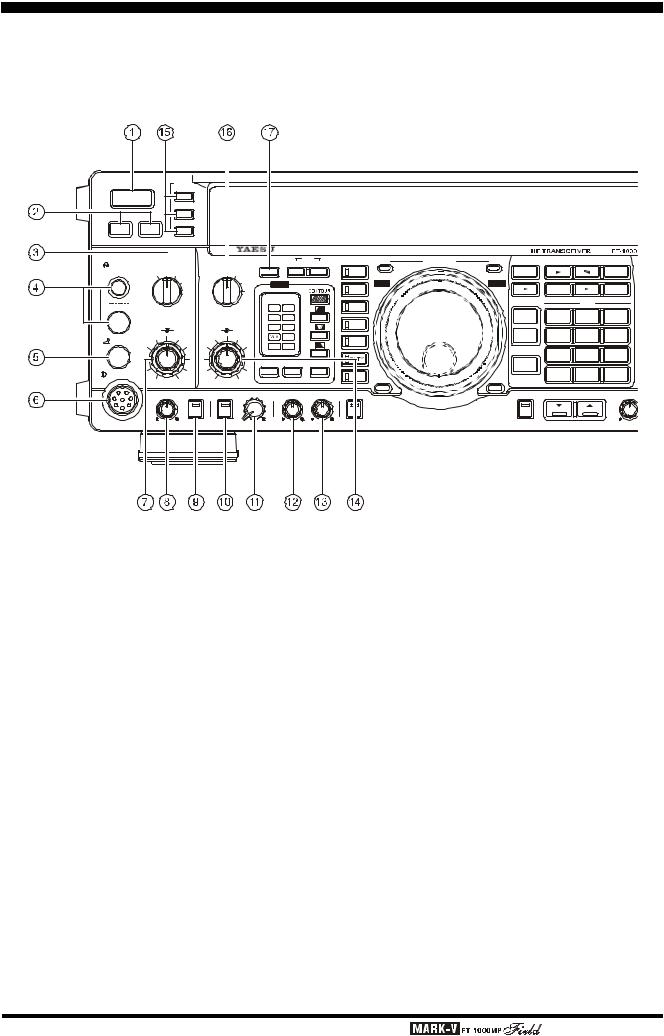
FRONT PANEL CONTROLS
This chapter describes each control and connector on the MARK-V FT-1000MP Field. You can just glance through it quickly now, but some of the descriptions will be more meaningful if you take the time to read them in detail now. If questions arise later while proceeding through the operation chapter, you can return to this chapter with the set powered up for control knob clarification. Some controls and switches are disabled under certain conditions.
POWER |
|
METER |
|
|
|
|
|
|
|
|
|
|
|
|
|
|
|
|
|
IC/SWR |
|
|
|
|
|
|
|
|
|
|
|
|
|
|
|
||
|
|
|
|
|
|
|
|
|
|
|
|
|
|
|
|
|
||
|
|
ALC/COMP |
|
|
|
|
|
|
|
|
|
|
|
|
|
|
|
|
MOX |
VOX |
VCC/MIC |
|
|
|
|
|
|
|
|
|
|
|
|
|
|
|
|
|
|
|
|
|
|
|
|
|
|
|
|
|
|
|
|
|
||
PHONES |
AGC |
|
|
ATT |
|
|
|
ANT |
RX |
MAIN |
VFO-A |
TX |
|
|
|
|
|
|
|
|
|
IPO |
A/B |
RX |
|
|
|
|
|
|
|||||||
|
|
|
|
|
|
|
|
|
|
|
|
|
||||||
A |
FAST |
|
|
0 |
|
|
|
|
LSB |
|
|
VFO/ |
A |
B |
A |
B |
M GRP |
|
OFF |
SLOW |
|
6 |
|
|
|
|
|
|
MEM |
||||||||
|
|
|
|
|
|
|
|
|
|
|
|
|
|
|||||
|
|
|
AUTO |
|
12 |
EDSP |
|
VRF |
|
|
IDBT |
|
|
|
|
|
|
|
|
|
|
|
|
|
|
|
|
|
|
|
|
|
|
||||
|
|
|
|
|
1 8 |
|
USB |
|
|
M |
A |
M CK |
A |
M |
RPT |
|||
|
|
|
|
|
|
|
|
|
|
|||||||||
|
|
|
|
|
(dB) |
APF NR |
|
|
|
|
QMB |
|
|
BAND |
|
|||
B |
|
|
|
|
|
240 |
A |
|
CW |
|
|
|
|
|
||||
|
|
|
|
|
|
|
|
|
|
1.8 |
|
3.5 |
|
7 |
||||
|
|
|
|
|
|
120 |
B |
|
|
|
|
RCL |
|
|
||||
|
|
|
|
|
|
|
|
|
|
|
1 |
|
2 |
3 |
||||
|
|
|
|
|
|
|
|
|
AM |
|
|
|
|
|
|
|||
|
MIC |
PROC |
AF |
RF |
60 |
C |
|
|
|
|
|
|
|
|
|
|
||
|
|
|
|
|
|
|
|
|
|
|
|
|||||||
|
GAIN |
GAIN |
|
|
|
|
|
|
STO |
10 |
|
14 |
|
18 |
||||
|
|
|
|
|
D |
|
|
|
|
|
|
|||||||
KEY |
|
|
|
|
|
|
|
FM |
|
|
|
4 |
|
5 |
6 |
|||
|
|
|
|
|
|
|
|
|
|
|
|
|
|
|||||
|
|
|
|
|
OFF |
OFF |
|
|
|
|
|
|
|
|
|
|
||
|
|
|
|
|
|
|
|
|
|
|
|
|
|
|
|
|
||
|
|
|
|
|
|
|
|
|
|
|
|
|
|
21 |
|
24.5 |
28 |
|
|
|
|
|
|
|
APF |
NR |
OFF |
|
|
|
|
|
|
7 |
|
8 |
9 |
|
|
|
|
|
|
|
|
|
DUAL |
|
|
|
|
|
||||
MIC |
|
|
|
|
|
|
|
|
PKT |
|
|
|
|
SUB |
|
29 |
|
ENT |
|
|
|
|
|
|
|
|
|
|
LOCK |
|
|
DE |
|
0 |
|
||
|
|
|
|
|
|
|
|
|
|
|
|
|
|
|
||||
|
|
|
|
|
|
|
|
|
FAST |
|
|
|
|
|
|
|
|
|
|
RF PWR |
PROC |
MONI |
SUB AF |
MONI |
SQL |
CLASS-A |
|
|
AF REV |
|
|
|
|
SUB S |
|||
|
|
|
|
|
|
|
|
|
|
|
|
|
|
DOWN |
|
UP |
|
|
 POWER Button
POWER Button
This button turns the transceiver on and off.
 MOX & VOX Buttons
MOX & VOX Buttons
[MOX] may be used in place of a microphone PTT switch or footswitch to activate the transmitter, when depressed. It must be in the undepressed position for reception.
[VOX] enables automatic voice-actuated transmitter switching in the SSB, AM and FM modes, and “semi- break-in” keying in CW mode. The controls affecting VOX operation are located in the top access panel. Menu Selection 7-5 sets the receiver recovery time during semi-break-in CW operation.
 AGC Selector Knob
AGC Selector Knob
Selects main receiver Automatic Gain Control decay time for most comfortable reception, or disables receiver AGC (off). Normally this switch is set to the “AUTO” position. Strong signals will cause distortion if this selector is set to “OFF.”
 PHONES Jack
PHONES Jack
A ¼-inch and 3.5 mm, 3-contact jack accept either monaural or stereo headphones with 2- or 3-contact plugs. When a plug is inserted, the loudspeaker is disabled. With stereo headphones such as the optional YH-77STA, you can monitor both receiver channels at the same time during dual reception. In this case, the headphone HP controls (page 32) beneath the top access panel adjust the default levels for mixed, separate, or monaural headphone operation.
 KEY Jack
KEY Jack
This ¼-inch, 3-contact jack accepts a CW key or keyer paddles (for the built-in electronic keyer), or output from an external electronic keyer. You cannot use a 2-contact plug in this jack (to do so produces a constant “key down” condition). Pinout is shown on page 4. Key up voltage is 5 V, and key down current is 0.5 mA. There is another jack with the same name, connected in parallel with this jack, on the rear panel.
 MIC Jack
MIC Jack
This 8-pin jack accepts input from the MH-31B8D Microphone. MIC connector pinout is shown on page 4. Proper microphone input impedance is 500 ~ 600 Ohms.
Page 22 |
OPERATING MANUAL |

 MIC
MIC 
 PROC Knob
PROC Knob
The inner MIC control adjusts the microphone input level for (non-processed) SSB and AM transmission.
The outer PROC control sets the compression (input) level of the transmitter RF speech processor in the SSB modes, when activated by the button with the same name.
 RF PWR Knob
RF PWR Knob
This control adjusts the transmitter’s output power in all modes. The adjustment range is from approximately 5 to 100 watts, except in the AM mode, where the permitted carrier level is about 5 to 25 watts. This knob also controls the carrier level for CW transmission. In setting the output power, the ALC function of the meter should always be monitored, to avoid overdriving the transmitter final amplifier.
In the “Class A” SSB operating mode, the adjustment range for power output will be between approximately 5 and 25 watts.
 PROC Button
PROC Button
This button enables the RF speech processor for SSB transmission. Processing level is set by the outer control with the same name. While activated, the LED in this button glows red.
 MONI Button
MONI Button
This orange button enables the transmit (RF) monitor in all modes (except CW, in which the monitor function is always on, to produce the sidetone). While activated, the LED in this button glows red.
 SUB AF Knob
SUB AF Knob
The SUB AF control adjusts the audio volume of the sub receiver VFO in the speaker or headphones.
The AF GAIN control, located above, and this SUB AF control can be rotated to adjust the relative balance of receiver audio between the two receiver channels during dual reception.
Menu selection 2-8 (AF GAin) allows the SUB AF control to be changed into a “Balance” control for the two audio channels, if desired. In this case, the AF GAIN control (see next column) will adjust the volume level for both the Main and Sub receivers, while the SUB AF control will control the balance. See page 101 for details.
 MONI Knob
MONI Knob
When activated by the [MONI] button (above), the audio level of the transmit RF monitor during transmission (relative to the AF GAIN control) is adjusted by this control.
FRONT PANEL CONTROLS
 SQL Knob
SQL Knob
This control sets the signal level threshold at which main VFO-A receiver audio is muted (and the green “MAIN BUSY” display indicator turns off), in all modes. This control is normally kept fully counter-clockwise, except when scanning and during FM operation.
 AF GAIN
AF GAIN 
 RF GAIN Knob
RF GAIN Knob
The inner AF GAIN control adjusts the audio volume of the main receiver VFO in the speaker or headphones.
The outer RF GAIN control adjusts the receiver signal level in front of the main receiver 1st mixer (via PIN diodes), and also the gain of the main receiver IF amplifiers.
It is normally set fully clockwise for maximum sensitivity. When rotated counter-clockwise, the S-meter minimum deflection point will move up the scale. The peak deflection for a particular signal will remain the same if it is greater than the level set by this control, but the main receiver will be less sensitive to weaker signals.
This control also affects the SQL setting for main VFO-A, and should be preset fully clockwise when setting the squelch threshold for the VFO or on a recalled memory.
 METER Selector Switches
METER Selector Switches
These switches determine the function of the multifunction meter during transmission. The meanings of the abbreviations are as follows:
IC/SWR - Final amplifier collector current (Amps) and Standing Wave Ratio (forward: reflected).
ALC/COMP - Relative Automatic Level Control voltage and RF speech compressor level (in dB, for SSB modes only).
VCC/MIC - Final amplifier collector voltage and microphone gain input level.
The meter indicates power output and the selected parameter during transmission, and signal strength in S-units during reception (on the main receiver). Each S-unit is approximately 6 dB.
 ATT Selector Knob
ATT Selector Knob
This knob inserts 6, 12, or 18 dB (1, 2, or 3 S-units) of attenuation before the mixer to suppress band noise and reduce the possibility of overload from very strong signals.
 IPO Button
IPO Button
The Intercept Point Optimization button may be used to set optimum receiver front end characteristics for a strong environment. Selecting IPO bypasses the front end RF amplifier and feeds the received signals directly to the first mixer.
OPERATING MANUAL |
Page 23 |
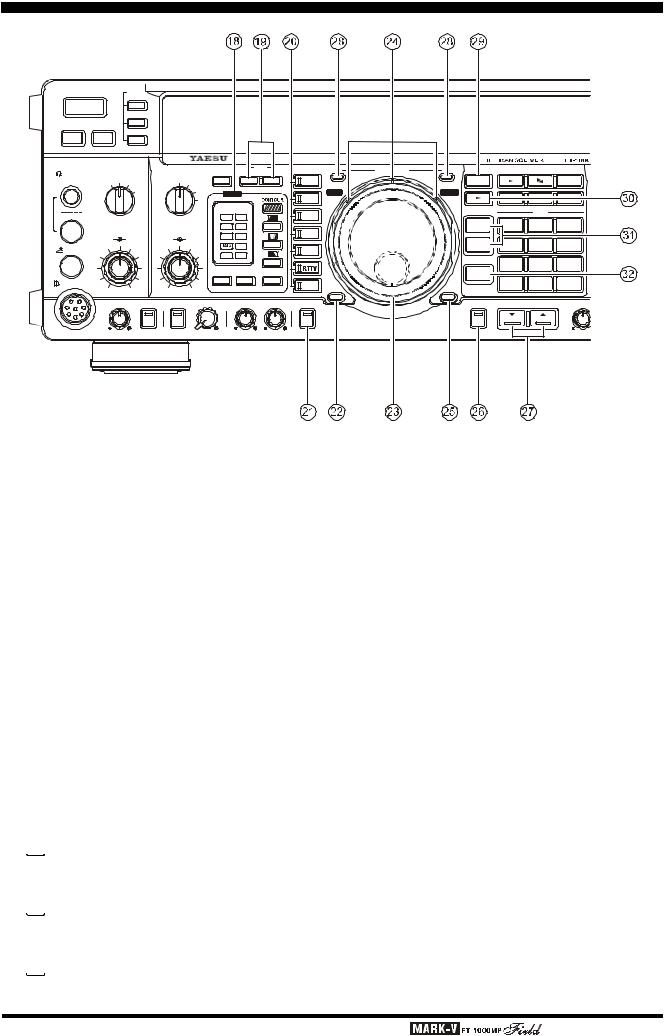
FRONT PANEL CONTROLS
POWER |
|
METER |
|
|
|
|
|
|
|
|
|
|
|
|
|
|
|
|
|
IC/SWR |
|
|
|
|
|
|
|
|
|
|
|
|
|
|
|
||
|
|
|
|
|
|
|
|
|
|
|
|
|
|
|
|
|
||
|
|
ALC/COMP |
|
|
|
|
|
|
|
|
|
|
|
|
|
|
|
|
MOX |
VOX |
|
|
|
|
|
|
|
|
|
|
|
|
|
|
|
|
|
|
|
VCC/MIC |
|
|
|
|
|
|
|
|
|
|
|
|
|
|
|
|
PHONES |
AGC |
|
|
ATT |
|
|
|
ANT |
|
RX |
MAIN |
VFO-A |
TX |
|
|
|
|
|
|
|
|
IPO |
A/B |
RX |
|
|
|
|
|
|
|||||||
|
|
|
|
|
|
|
|
|
|
|
|
|
||||||
A |
FAST |
|
|
0 |
|
|
|
|
LSB |
|
|
|
VFO/ |
A |
B |
A |
B |
M GRP |
OFF |
SLOW |
|
6 |
|
|
|
|
|
|
MEM |
||||||||
|
|
|
AUTO |
|
12 |
EDSP |
|
|
VRF |
|
|
IDBT |
|
|
|
|
|
|
|
|
|
|
|
|
|
USB |
|
|
|
|
|
|
|
||||
|
|
|
|
|
1 8 |
|
|
|
|
M A |
M CK |
A |
M |
RPT |
||||
|
|
|
|
|
|
|
|
|
|
|
||||||||
|
|
|
|
|
(dB) |
APF NR |
|
|
|
|
|
QMB |
|
|
BAND |
|
||
B |
|
|
|
|
|
240 |
A |
|
CW |
|
|
|
|
|
|
|||
|
|
|
|
|
|
|
|
|
|
1.8 |
|
3.5 |
|
7 |
||||
|
|
|
|
|
|
120 |
B |
|
|
|
|
|
RCL |
|
|
|||
|
|
|
|
|
|
|
|
|
|
|
|
1 |
|
2 |
3 |
|||
|
|
|
|
|
|
|
|
|
AM |
|
|
|
|
|
|
|||
|
MIC |
PROC |
AF |
RF |
60 |
C |
|
|
|
|
|
|
|
|
|
|
||
|
|
|
|
|
|
|
|
|
|
|
|
|||||||
|
GAIN |
GAIN |
|
|
|
|
|
|
|
STO |
10 |
|
14 |
|
18 |
|||
|
|
|
|
|
D |
|
|
|
|
|
|
|
||||||
KEY |
|
|
|
|
|
|
|
FM |
|
|
|
|
4 |
|
5 |
6 |
||
|
|
|
|
|
|
|
|
|
|
|
|
|
|
|||||
|
|
|
|
|
OFF |
OFF |
|
|
|
|
|
|
|
|
|
|
||
|
|
|
|
|
|
|
|
|
|
|
|
|
|
|
|
|
||
|
|
|
|
|
|
|
|
|
|
|
|
|
|
21 |
|
24.5 |
28 |
|
|
|
|
|
|
|
APF |
NR |
|
|
|
|
|
|
|
7 |
|
8 |
9 |
|
|
|
|
|
|
OFF |
|
|
|
|
DUAL |
|
|
|
|
|
||
MIC |
|
|
|
|
|
|
|
|
PKT |
FAST |
|
|
LOCK |
SUB |
DE |
29 |
0 |
ENT |
|
|
|
|
|
|
|
|
|
|
|
|
|
|
|||||
|
|
|
|
|
|
|
|
|
|
|
|
|
|
|
|
|
||
|
RF PWR |
PROC |
MONI |
SUB AF |
MONI |
SQL |
CLASS-A |
|
|
|
AF REV |
|
|
|
|
SUB S |
||
|
|
|
|
|
|
|
|
|
|
|
|
|
|
DOWN |
|
UP |
|
|
 EDSP Filters
EDSP Filters
(A) APF
Selects and indicates the bandwidth for the EDSP CW audio peaking filter. Pressing the [APF] switch selects the bandwidth to be used for the EDSP CW audio peaking filter, with available selections of 240(Hz)/ 120(Hz)/60(Hz)/DATA (DATA is an optimized bandwidth for FAX, PACKET or SSTV operation, user-optimized via the Menu), or “OFF,” and the indicator changes according to the bandwidth selected. The most narrow setting is highly useful for very-weak-signal CW work.
(B) NR
Selects and indicates the setting of the EDSP Noise Reduction feature. Pressing the [NR] switch selects one of four EDSP noise reduction settings, and the indicator changes according to the selection chosen (choose the selection providing the most effective reduction of noise under current operating conditions).
(C) CONTOUR
Press one of these four switches to select the desired EDSP (CONTOUR) filter.
 : Low Cut Filter (High-frequency emphasis) Pressing this button activates the EDSP Low Cut Filter; the CONTOUR LED will glow green.
: Low Cut Filter (High-frequency emphasis) Pressing this button activates the EDSP Low Cut Filter; the CONTOUR LED will glow green.
 :Mid Cut Filter (High- & Low-frequency emphasis) Pressing this button activates the EDSP Medium Cut Filter; the CONTOUR LED will glow orange.
:Mid Cut Filter (High- & Low-frequency emphasis) Pressing this button activates the EDSP Medium Cut Filter; the CONTOUR LED will glow orange.
 : High Cut Filter (Low-frequencies emphasis) Pressing this button activates the EDSP High Cut Filter; the CONTOUR LED will glow red.
: High Cut Filter (Low-frequencies emphasis) Pressing this button activates the EDSP High Cut Filter; the CONTOUR LED will glow red.
OFF:
EDSP filter is off; the CONTOUR LED will go out.
 ANT [A/B RX] Buttons
ANT [A/B RX] Buttons
[A/B] - Pressing this selects either the ANT A or B jack on the rear panel, and allows convenient antenna switching at the press of a button. The selected antenna jack is also indicated at the top of the display (above the channel group number).
[RX] - Normally, the antenna connected to the ANT A or B jack is used for receive (and always used for transmitting). When this switch is pressed (display indicator on), an antenna connected to the RX ANT IN jack is used during receive.
 MODE Selection Buttons
MODE Selection Buttons
These momentary buttons select the operating mode, indicated by the LED in each button. Pressing AM, CW, RTTY, or PKT multiple times will switch between the alternate operating features that can be used by these modes (covered later). Also, when you press and hold in the [PKT] key for one second, the userprogrammed custom function setting mode will be activated.
Page 24 |
OPERATING MANUAL |

 CLASS-A Button
CLASS-A Button
This button changes the final amplifier operating mode to Class-A. When operating the final amplifier in the Class-A mode, the maximum output power will be reduced to approximately 25 watts, and the LED inside this button will glow red. Operating SSB in Class- A yields an ultra-clean signal waveform.
 FAST Button
FAST Button
For fast tuning, press this button (the “FAST” icon will appear), then rotate the main or sub tuning knobs (or press the UP(p) or DOWN(q) button). The tuning rate will increase ten times.
 MAIN VFO-A Tuning Knob
MAIN VFO-A Tuning Knob
This large knob adjusts the operating frequency of Main VFO-A (or a recalled memory). Default tuning increments are 10 Hz (100 Hz in AM and FM modes). When the [FAST] button has been pressed, the increments are 10x these sizes. See the table on page 38 for a listing of all available steps.
 Shuttle Jog and VRF & IDBT Buttons
Shuttle Jog and VRF & IDBT Buttons
The Shuttle Jog ring allows fine or rapid frequency excursions with just a slight turn of your hand. Rotating the ring slightly either to the left or the right tunes downward or upward a few steps. The tuning rate increases the farther the ring is rotated.
Pressing the [VRF] button on the left side of the Shuttle Jog activates the VRF (Variable RF Front-end Filter), which adds a narrow input preselector filter into the RF receiver circuit on the 160-20 meter Amateur bands. Its passband can be tuned by rotating the VRF/ MEM CH knob, located on the upper right corner of the front panel, for maximum sensitivity and out-of-band interference rejection.
Pressing the [IDBT] button on the right side of the Shuttle Jog activates the IDBT (Interlocked Digital Bandwidth Tracking) System, which matches the EDSP (Bandwidth) filter characteristics to the settings of the SHIFT and WIDTH knobs. Thus, it is not necessary to re-adjust the EDSP settings if you change the (IF) WIDTH and/or SHIFT settings; the EDSP settings will automatically follow those of the higher-frequency IF passband.
 LOCK Button
LOCK Button
This button toggles locking of the main tuning knob to prevent accidental frequency changes. “LOCK” is displayed in a red box below and to the left of the main frequency display field when this command is active (the tuning knob can still be turned, but it does nothing). Press [LOCK] again to enable the tuning knob.
FRONT PANEL CONTROLS
 AF REV Button
AF REV Button
Pressing this reverses the main/sub receiver audio adjusted using the AF GAIN knob and SUB AF knob. When activated, the LED inside this button glows red.
 DOWN(q) & UP(p) Buttons
DOWN(q) & UP(p) Buttons
Pressing either of these buttons momentarily steps the operating frequency down or up 100 kHz, respectively. Pressing and holding the [FAST] button while pressing one of these buttons steps the frequency down or up 1 MHz. Continue holding either button for repeated stepping.
 MAIN VFO-A [RX & TX Switch-LED]
MAIN VFO-A [RX & TX Switch-LED]
These combination lamp-switches select and indicate the transmit/receive status of the main tuning knob and display. When the green “RX” lamp is lit, the receiving frequency is under control of the main knob and display (either VFO-A or a recalled memory channel). When the red “TX” lamp is lit, the transmitting frequency is under control of the main knob and display. Thus, for “normal” (non-split) operation, both the red and green lamps associated with the main tuning knob will be illuminated.
 VFO/MEM Button
VFO/MEM Button
This button toggles main receiver operation between the memory channel and the main VFO-A. Either “VFO,” “MEM,” or “M TUNE” will be displayed to the left of the main frequency display field to indicate the current selection. If a displayed memory has been retuned, pressing this button returns the display to the original memory contents, and pressing it again returns operation to the Main VFO.
 [M uA] Button
[M uA] Button
Pressing this button momentarily displays the contents of the currently-selected memory channel for three seconds. Holding this button for ½ second copies the data from the currently selected memory to the Main VFO-A, as two beeps sound. Previous data in the Main VFO will be overwritten.
 QMB Buttons
QMB Buttons
[RCL] (Recall) - Recalls one of up to five Quick Memory Bank memories for operation.
[STO] (Store) - Pressing this copies operating parameters into consecutive QMB Memories.
 [DUAL] Button
[DUAL] Button
This button activates dual-channel reception with the main and sub receivers. When this function is active, “DUAL” will be displayed in a box at the left edge of the display.
OPERATING MANUAL |
Page 25 |
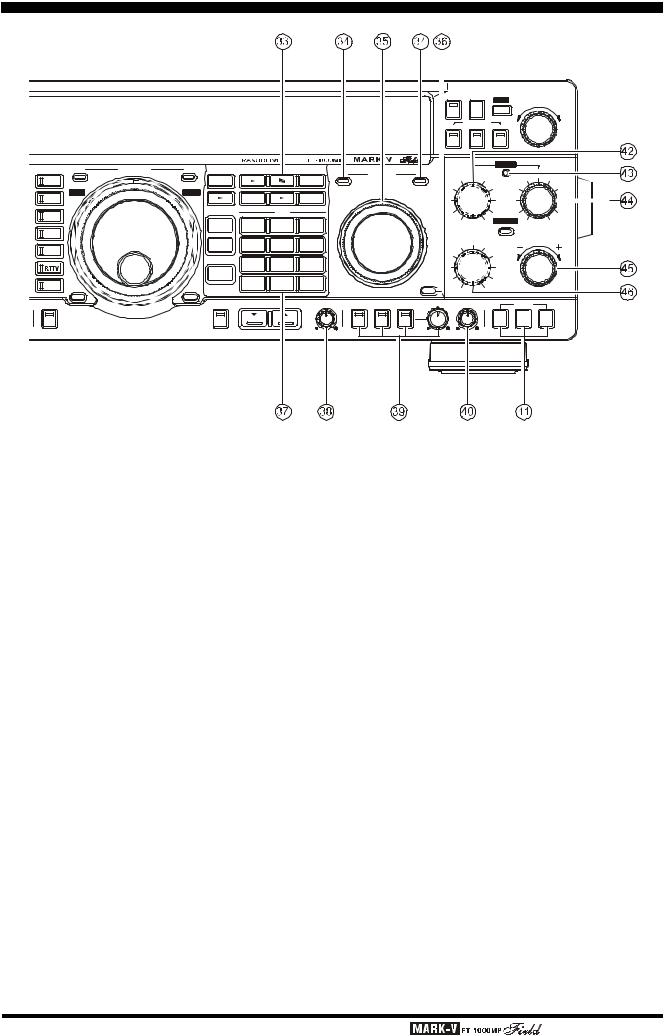
FRONT PANEL CONTROLS
|
|
|
|
|
|
|
|
|
|
|
|
|
NB |
TUNER |
VRF |
VRF/MEM CH |
|
|
|
|
|
|
|
|
|
|
|
|
|
|
|
|
DWN |
UP |
|
|
|
|
|
|
|
|
|
|
|
|
|
|
|
|
|
||
|
|
|
|
|
|
|
|
|
|
|
|
|
NOR |
BAND WIDTH |
NAR2 |
|
|
|
|
|
|
|
|
|
|
|
|
|
|
|
NAR1 |
|
|
||
|
RX |
MAIN |
VFO-A |
TX |
|
|
|
|
|
|
|
|
|
|
IDBT |
|
|
|
|
|
|
|
RX |
|
SUB VFO-B |
TX |
|
SHIFT |
|
|
WIDTH |
||||
|
|
|
|
VFO/ |
|
|
|
|
|
|
|
|
|||||
LSB |
|
|
|
A |
B |
A |
B |
M GRP |
|
|
|
|
|
|
|
|
|
|
|
|
MEM |
|
|
|
|
|
|
|
|
||||||
USB |
VRF |
|
|
IDBT |
|
|
|
|
|
|
|
|
|
|
|
|
|
|
|
|
M A |
M CK |
A |
M |
RPT |
|
|
|
|
|
|
|
|
||
CW |
|
|
|
QMB |
|
|
BAND |
|
|
|
|
|
|
|
|
|
|
|
|
|
|
|
|
|
|
|
|
|
|
|
|
NOTCH |
|
||
|
|
|
|
RCL |
1.8 |
|
3.5 |
|
7 |
|
|
|
|
|
|
||
|
|
|
|
|
1 |
|
2 |
3 |
|
|
|
|
|
|
|
|
|
AM |
|
|
|
|
|
|
|
|
|
|
|
|
|
|
|||
|
|
|
|
|
|
|
|
|
|
|
|
|
NOTCH |
|
|
CLAR |
|
|
|
|
|
STO |
10 |
|
14 |
|
18 |
|
|
|
|
|
|
||
|
|
|
|
|
|
|
|
|
|
|
|
|
|
||||
FM |
|
|
|
|
4 |
|
5 |
6 |
|
|
|
|
|
|
|
|
|
|
|
|
|
|
|
|
|
|
|
|
|
|
|
||||
|
|
|
|
|
|
|
|
|
|
|
|
|
|
|
|
|
|
|
|
|
|
|
21 |
|
24.5 |
|
28 |
|
|
|
|
|
|
|
|
|
|
|
|
|
|
7 |
|
8 |
9 |
|
|
|
|
|
|
|
|
|
|
|
|
DUAL |
|
|
|
|
|
|
|
|
|
|
|
|
|
PKT |
|
|
|
|
SUB |
|
29 |
|
ENT |
|
|
LOCK |
|
|
|
|
|
|
|
|
|
|
DE |
|
0 |
|
|
|
|
|
|
|
|
||
FAST |
|
|
LOCK |
|
|
|
|
|
|
|
|
|
|
|
|||
|
|
|
|
|
|
|
|
|
|
|
|
|
|
|
|
||
CLASS-A |
|
|
|
AF REV |
|
|
|
|
SUB SQL |
SPOT |
BK-IN KEYER |
SPEED |
PITCH |
|
CLAR |
||
|
|
|
|
|
DOWN |
|
UP |
|
|
|
|
|
|
|
|
|
|
|
|
|
|
|
|
|
|
|
|
|
|
|
|
|
RX |
TX |
CLEAR |
 VFO & Memory Control
VFO & Memory Control
[AuB] Button:
Pressing this button for ½ second (until the double beep) transfers data from the main display (either Main VFO-A or a recalled memory channel) to Sub VFO-B, overwriting any previous contents in the Sub VFO. Use this key to set both Main and Sub Receivers to the same frequency and mode.
[AutB] Button:
Pressing this button momentarily exchanges the contents of Main VFO-A (or a recalled memory channel), and Sub VFO-B. No data is lost.
[M GRP] Button:
When more than one memory group has been enabled, pressing this button limits selection and scanning to those memories within the selected group.
[M CK] (Memory Check) Button:
This key displays the contents of memory channels without disturbing operation. When pressed, “M CK” is displayed above the channel number, and each memory channel can then be checked on the Sub Receiver display by rotating the VRF/MEM CH selector. Empty memory channels display as two decimals, with no frequency digits. Press this button again to cancel memory checking.
[AuM] Button:
Pressing and holding in this key for ½ second (until the double beep) copies the current operating data from Main VFO-A, or a recalled memory, to the currently selected memory channel, overwriting any previous data stored there. Also, pressing and holding this button after recalling a memory, without first retuning, causes the memory channel to be “masked,” and repeating the process restores the masked memory.
[RPT] Button:
For 29 MHz FM operation, this button activates the standard HF FM repeater offset. Pressing [RPT] once or twice while receiving causes the transmit frequency to be shifted 100 kHz below or above the receiving frequency, respectively. A selectable CTCSS subaudible tone is also transmitted automatically when using this feature, to allow access to repeaters that require it. Pressing [RPT] a third time cancels repeater shift operation.
 SUB VFO-B [RX & TX Switch-LED]
SUB VFO-B [RX & TX Switch-LED]
These lamps select and indicate the current status of Sub VFO-B. When the green “RX” lamp is lit, the receiving frequency is under control of SUB VFO-B. When the red “TX” lamp is lit, the transmitting frequency is under control of SUB VFO-B. During dual receive operation, the green “RX” lamps above both tuning knobs Main and Sub) will be illuminated.
Page 26 |
OPERATING MANUAL |

 SUB VFO-B Tuning Knob
SUB VFO-B Tuning Knob
This knob adjusts the Sub VFO-B operating frequency. The available tuning increments are the same as described for the main tuning knob, although each tuning knob’s increments may be set independently (see page 38).
 [LOCK] Button
[LOCK] Button
This button toggles locking of SUB VFO-B tuning to prevent accidental frequency changes. The red indicator in the display glows when this command is active (the tuning knob can still be turned, but it does nothing). Press the [LOCK] button again to re-enable the tuning knob.
 BAND (Keypad)
BAND (Keypad)
The keypad provides one-touch band selection, or direct frequency entry. Normally, pressing one of the ten white numbered keys selects the corresponding (MHz) amateur band for operation (pressing the SUB button first, followed by a [BAND] key, selects that band for the Sub VFO). If you press the white numbered key for the band you are already on, you will select the alternate subband VFO on that band. See the “Operation” chapter for details.
If the [ENT] key is pressed first, the yellow labels on the keys become effective, for manually entering any frequency one digit at a time; press [SUB(CE)] then [ENT] to enter Sub-VFO frequencies directly.
 SUB SQL Knob
SUB SQL Knob
This separate control sets the signal level threshold at which SUB VFO-B receiver audio is muted (and the green “SUB BUSY” display indicator turns off), in all modes. This control is normally kept fully CCW, except when scanning and during FM operation.
 CW and Electronic Keyer Controls
CW and Electronic Keyer Controls
[SPOT] button turns the CW receiver spotting heterodyne oscillator on and off.
[BK-IN] button turns full break-in (QSK) CW operation on and off.
[KEYER] button toggles the internal CW keyer on/ off, as indicated by the LED above this button.
[SPEED] knob adjusts the keying speed of the keyer.
 PITCH Knob
PITCH Knob
Rotate this control to select your desired CW tone pitch (from 300~1050 Hz, in 50 Hz increments), as shown in the display. The Tx sidetone, receiver IF passband, and display offset from the BFO (carrier) frequency are all affected simultaneously.
FRONT PANEL CONTROLS
 [CLAR] Buttons
[CLAR] Buttons
Pressing the [RX] button activates the CLAR knob, to allow offsetting the receiving frequency temporarily (see item  below). The [TX] button provides the same function for the transmit frequency. If both buttons are pressed, the receiver and transmitter are both offset from the original frequency. Pressing the [CLEAR] button zeroes any offset tuned by the CLAR knob. Each memory and VFO retains all Clarifier settings independently.
below). The [TX] button provides the same function for the transmit frequency. If both buttons are pressed, the receiver and transmitter are both offset from the original frequency. Pressing the [CLEAR] button zeroes any offset tuned by the CLAR knob. Each memory and VFO retains all Clarifier settings independently.
 SHIFT Knob
SHIFT Knob
This knob offsets the center frequency of the IF passband when rotated from its “normal” (center) position. This control functions in all modes except FM.
When the IDBT System is activated by pressing the [IDBT] button on the Shuttle Jog, the EDSP (Bandpass) filter’s passband offset changes according to this knob’s setting.
 IDBT Indicator
IDBT Indicator
This red indicator lights up when the IDBT System is activated by pressing the [IDBT] button on the Shuttle Jog. When this indicator is illuminated, the EDSP (Bandpass) filter’s bandwidth and center frequency change according to the SHIFT and WIDTH knob settings.
 WIDTH Knob
WIDTH Knob
This knob, when turned from center, reduces the overall IF bandwidth from either the lower or upper side, from the maximum selected by the [BANDWIDTH] buttons.
When the IDBT feature is activated by pressing the [IDBT] button on the Shuttle Jog, the EDSP (Bandpass) filter’s passband width is reduced according to this knob’s setting.
 CLAR Knob
CLAR Knob
This knob tunes the Clarifier offset frequency up to 9.99 kHz when activated by the CLAR [RX] [TX] buttons just below it (a 3-digit display appears in the center of the display (if enabled) when the Clarifier is active).
 NOTCH Knob
NOTCH Knob
This knob adjusts the IF notch frequency when this feature is activated by the [NOTCH] button located above this knob. When activated, the LED inside the [NOTCH] button glows red.
Note that the setting of menu selection 2-9 may disable the action of this knob (if menu selection 2-9 is set to Auto DSP). With this selection, the EDSP Automatic Notch will be activated, and the IF Notch will be disabled.
OPERATING MANUAL |
Page 27 |
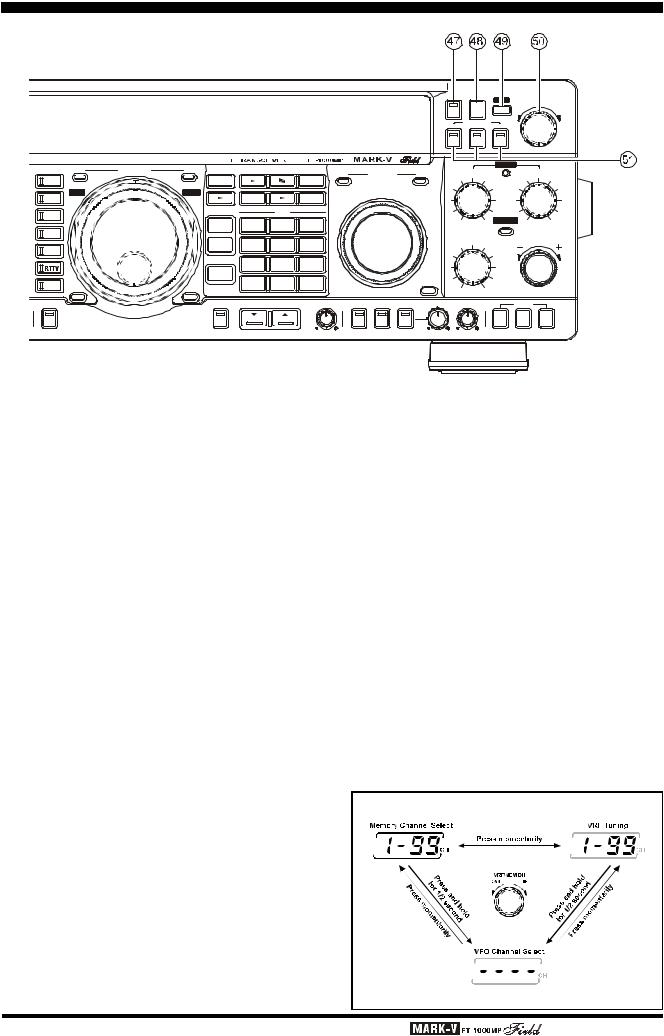
FRONT PANEL CONTROLS
|
|
|
|
|
|
|
|
|
|
|
|
NB |
TUNER |
VRF/MEM CH |
|
|
|
|
|
|
|
|
|
|
|
|
|
|
|
VRF |
UP |
|
|
|
|
|
|
|
|
|
|
|
|
|
|
DWN |
|
|
|
|
|
|
|
|
|
|
|
|
|
NOR |
BAND WIDTH |
|
|
|
|
|
|
|
|
|
|
|
|
|
|
NAR1 |
NAR2 |
|
|
|
RX |
MAIN |
VFO-A |
TX |
|
|
|
|
|
|
|
|
|
IDBT |
|
|
|
|
|
|
RX |
|
SUB VFO-B |
TX |
SHIFT |
WIDTH |
|
||||
|
|
|
|
VFO/ |
|
|
|
|
|
|
|||||
LSB |
|
|
|
A |
B |
A |
B |
M GRP |
|
|
|
|
|
|
|
|
|
|
|
MEM |
|
|
|
|
|
|
|
|
|
|
|
USB |
VRF |
|
|
IDBT |
|
|
|
|
|
|
|
|
|
|
|
|
|
|
M A |
M CK |
A |
M |
RPT |
|
|
|
|
|
|
||
CW |
|
|
|
QMB |
|
|
BAND |
|
|
|
|
|
|
|
|
|
|
|
|
|
|
|
|
|
|
|
|
|
NOTCH |
|
|
|
|
|
|
RCL |
1.8 |
|
3.5 |
|
7 |
|
|
|
|
|
|
|
|
|
|
|
1 |
|
2 |
3 |
|
|
|
|
|
|
|
AM |
|
|
|
|
|
|
|
|
|
|
|
|
|||
|
|
|
|
|
|
|
|
|
|
|
|
NOTCH |
CLAR |
|
|
|
|
|
|
STO |
10 |
|
14 |
|
18 |
|
|
|
|
||
|
|
|
|
|
|
|
|
|
|
|
|
||||
FM |
|
|
|
|
4 |
|
5 |
6 |
|
|
|
|
|
|
|
|
|
|
|
|
|
|
|
|
|
|
|
||||
|
|
|
|
|
|
|
|
|
|
|
|
|
|
|
|
|
|
|
|
|
21 |
|
24.5 |
28 |
|
|
|
|
|
|
|
|
|
|
|
|
|
7 |
|
8 |
9 |
|
|
|
|
|
|
|
|
|
|
DUAL |
|
|
|
|
|
|
|
|
|
|
|
PKT |
|
|
|
|
SUB |
|
29 |
|
ENT |
|
|
LOCK |
|
|
|
|
|
|
|
|
DE |
|
0 |
|
|
|
|
|
|
||
FAST |
|
|
LOCK |
|
|
|
|
|
|
|
|
|
|||
|
|
|
|
|
|
|
|
|
|
|
|
|
|
||
CLASS-A |
|
|
|
AF REV |
|
|
|
|
SUB SQL |
SPOT |
BK-IN KEYER |
SPEED |
PITCH |
CLAR |
|
|
|
|
|
|
DOWN |
|
UP |
|
|
|
|
|
|
|
|
RX TX CLEAR
 NB Button
NB Button
Pressing this button activates the IF Noise Blanker, which may help reduce many different types of manmade impulse noise (but not atmospherics). When the Noise Blanker is activated, the LED inside button will glow red.
You can select the Noise Blanker Type (for shortduration pulses or for long-duration pulses) and its blanking level via menu selection 2-8.
 [TUNER] Button
[TUNER] Button
This is the on/off switch for the MARK-V FT-1000MP Field’s Automatic Antenna Tuner.
Pressing this button momentarily places the antenna tuner in line between the transmitter final amplifier and the main antenna jack. Reception is not affected.
Pressing and holding this button for ½ second while receiving in an amateur band activates the transmitter for a few seconds while the automatic antenna tuner rematches the antenna system impedance for minimum SWR. The resulting settings are automatically stored in one of the antenna tuner’s 39 memories, for instant automatic recall later when the receiver is tuned near the same frequency.
 VRF Indicator
VRF Indicator
This indicator glows red when the VRF feature is activated by pressing the [VRF] button on the Shuttle Jog.
 VRF/MEM CH Knob
VRF/MEM CH Knob
When the VRF feature is engaged, use this detended knob to tune the passband of the narrow input preselector filter manually for maximum receiver sensitivity (and out-of-band interference rejection).
At other times (when the VRF feature is “off”), this knob selects the operating memory channel when the memories are active (but not retuned). When the VFO or memory tune functions of the main display are active, turning this knob causes the Sub VFO display to temporarily show the frequencies of the memories (memory check), without otherwise affecting operation. The channel number of the selected memory is displayed at all times at the center right of the display (in front of “CH”).
Pressing and holding this knob for ½ second enables the “VFO Step” feature, which allows “channellizing” the VFO for quick frequency navigation. Menu Selection 1-5 sets the VFO Channel step size.
VRF/MEM CH Knob Sequence
Note: VRF only functions on the 160-20 M Amateur Bands
Page 28 |
OPERATING MANUAL |
